Articles
- Page Path
- HOME > Osong Public Health Res Perspect > Forthcoming articles > Article
-
Original Article
AI-powered COVID-19 forecasting: a comprehensive comparison of advanced deep learning methods -
Muhammad Usman Tariq1,2
 , Shuhaida Binti Ismail2
, Shuhaida Binti Ismail2
-
DOI: https://doi.org/10.24171/j.phrp.2023.0287
Published online: March 28, 2024
1Marketing, Operations, and Information System, Abu Dhabi University, Abu Dhabi, United Arab Emirates
2Faculty of Computer Science and Information Technology, Univesiti Tun Hussien Onn Malaysia, Parit Raja, Malaysia
- Corresponding author: Muhammad Usman Tariq Marketing, Operations, and Information System, Abu Dhabi University, Zayed City, Abu Dhabi, United Arab Emirates E-mail: usmankazi100@gmail.com
© 2024 Korea Disease Control and Prevention Agency.
This is an open access article under the CC BY-NC-ND license (http://creativecommons.org/licenses/by-nc-nd/4.0/).
- 347 Views
- 10 Download
Abstract
-
Objectives
- The coronavirus disease 2019 (COVID-19) pandemic continues to pose significant challenges to the public health sector, including that of the United Arab Emirates (UAE). The objective of this study was to assess the efficiency and accuracy of various deep-learning models in forecasting COVID-19 cases within the UAE, thereby aiding the nation’s public health authorities in informed decision-making.
-
Methods
- This study utilized a comprehensive dataset encompassing confirmed COVID-19 cases, demographic statistics, and socioeconomic indicators. Several advanced deep learning models, including long short-term memory (LSTM), bidirectional LSTM, convolutional neural network (CNN), CNN-LSTM, multilayer perceptron, and recurrent neural network (RNN) models, were trained and evaluated. Bayesian optimization was also implemented to fine-tune these models.
-
Results
- The evaluation framework revealed that each model exhibited different levels of predictive accuracy and precision. Specifically, the RNN model outperformed the other architectures even without optimization. Comprehensive predictive and perspective analytics were conducted to scrutinize the COVID-19 dataset.
-
Conclusion
- This study transcends academic boundaries by offering critical insights that enable public health authorities in the UAE to deploy targeted data-driven interventions. The RNN model, which was identified as the most reliable and accurate for this specific context, can significantly influence public health decisions. Moreover, the broader implications of this research validate the capability of deep learning techniques in handling complex datasets, thus offering the transformative potential for predictive accuracy in the public health and healthcare sectors.
- The coronavirus disease 2019 (COVID-19) pandemic has profoundly impacted countries worldwide, including the United Arab Emirates (UAE). The UAE has faced significant challenges in controlling the spread of the virus and in managing its consequences. The accurate forecasting of pandemic dynamics is vital for effective decision-making and resource allocation by healthcare organizations, governments, and policymakers. In recent years, deep learning models have demonstrated remarkable performance in solving various challenges in the fields of healthcare, image processing, text recognition, and natural language processing [1]. These models have been successfully applied to a range of COVID-19 forecasting tasks and their use in predicting the progression of the pandemic in the UAE is of particular interest. This literature review examines the application of advanced deep learning models for COVID-19 forecasting in the UAE and provides a comparative analysis of their performances [2,3].
- Several studies have used deep learning models to predict the progression of the UAE pandemic. For example, some studies have applied multi-input, multi-output convolutional neural network (CNN) models to forecast COVID-19 cases in multiple countries, including the UAE [4–6]. Their results indicated that CNN models could effectively capture local patterns in the data and provide accurate forecasts. Similarly, other studies have explored the use of long short-term memory (LSTM) and bidirectional LSTM (Bi-LSTM) models for COVID-19 forecasting in the region, demonstrating their ability to capture complex temporal dependencies in the data and provide reliable predictions [7–11]. The deep learning models discussed in this review include LSTM, Bi-LSTM, CNN, CNN-LSTM hybrid, recurrent neural network (RNN), and multilayer perceptron (MLP) models [6,12–15]. These models have been employed in various studies to forecast COVID-19 cases, deaths, and recoveries as well as to predict the impact of different government interventions and public health measures. The models were used in the context of UAE to find the best-performing model with and without Bayesian optimization, which was selected as one of the best available optimization parameters that could be applied to all the selected models in this study. This study aimed to determine the best model to predict COVID-19 in the UAE. The paper is further divided into Section 2, which provides a detailed background of the COVID-19 pandemic in the UAE; Section 3, which provides information on common models; Section 4, which provides details on preprocessing; Section 5, which provides results and discussion; and Section 6, which presents recommendations, conclusions, and future work.
- Contributions to Existing Studies
- This study offers several distinct contributions to the academic community and public health policymakers.
- This research is among the first to conduct a comprehensive analysis of multiple deep learning models, including LSTM, Bi-LSTM, CNN, CNN-LSTM, MLP, and RNN models, specifically for predicting COVID-19 cases in the UAE.
- Unlike previous studies that have focused on a singular aspect, such as confirmed cases, this research incorporates a more comprehensive dataset, including demographic information and socioeconomic indicators, thereby providing a holistic overview for more accurate predictions.
- Utilizing Bayesian optimization, this study goes a step further in fine-tuning the models, which has not been commonly carried out in similar studies. This optimization substantially increased the reliability and accuracy of the predictive models.
- This research not only serves academic purposes, but also has substantial real-world applications. It directly aids public health decision-making, enabling authorities to implement targeted and data-driven interventions, which is particularly crucial when pandemics occur.
- Our models, especially the RNN model, which showed the best performance without any prior optimization, can serve as a framework for predicting not only COVID-19 cases, but also cases of other infectious diseases, thus having broader implications for healthcare. It has often been pointed out that RNNs have issues of interpretability that can slow down decision-making and may require additional resources to validate the model performance, but this was resolved by developing hybrid models to ensure timely decision-making.
- This study is one of the few that uses both predictive and perspective analytics to provide a multidimensional analysis of COVID-19 trends and patterns, thereby adding a layer of depth to data interpretation.
- Background
- The principal motivation for employing a comparative study of advanced deep learning models lies in the unpredictable nature of the pandemics. Traditional epidemiological models have shown limitations in capturing the dynamic variables that affect virus transmission, such as behavioral changes and policy interventions. By leveraging deep learning, this study aims to offer a more adaptive and accurate framework for COVID-19 forecasting in the UAE.
- Since the first reported case in January 2020, the UAE has implemented strict measures to control the spread of the virus. The country’s response evolved over time, adapting to the changing landscape of the pandemic. Some of the key aspects of the UAE’s response include lockdowns, travel restrictions, mass vaccination campaigns, healthcare infrastructure expansion, and testing and tracing capacities. This section elaborates on these aspects to provide a more comprehensive understanding of the COVID-19 pandemic in the UAE [16].
- In the early stages of the pandemic, the UAE imposed strict lockdowns and curfews to minimize the spread of the virus. These measures included closing nonessential businesses, suspending schools and universities, and restricting movement. The UAE has also implemented travel restrictions, including banning flights from high-risk countries, imposing quarantine measures for inbound travelers, and requiring negative polymerase chain reaction (PCR) tests for international passengers [17].
- The UAE has been proactive in securing COVID-19 vaccines and in initiating mass vaccination campaigns. The country initiated its vaccination program in December 2020, prioritizing healthcare workers, elderly citizens, and people with chronic diseases. Since then, the UAE has expanded its vaccination efforts to include the general public with several available vaccines, including Sinopharm, Pfizer-BioNTech, and AstraZeneca. By September 2021, the UAE had one of the world’s highest vaccination rates, with more than 90% of its population having received at least 1 dose. Currently, the UAE accounts for 100% of all vaccinated residents [18].
- To effectively combat the COVID-19 pandemic, the UAE invested significantly in expanding its healthcare infrastructure. The country established numerous field hospitals, isolation centers, and testing facilities to accommodate the increasing number of cases. In addition, the UAE increased its healthcare workforce by recruiting more medical professionals and support staff to meet the demand. This expansion not only helped manage the pandemic, but also improved the country’s overall healthcare capabilities [19].
- An essential aspect of the UAE’s response to the COVID-19 pandemic was its focus on ramping up the testing and tracing capacities to detect and contain the virus. The country implemented widespread testing, including drive-through testing centers, home testing services, and rapid PCR tests at airports. In addition to testing, the UAE employed advanced contact-tracing methods using smartphone applications and AI-driven tools to identify and isolate individuals who have been exposed to the virus. These efforts played a crucial role in controlling the spread of COVID-19 in the UAE [20,21].
- Predicting the spread of COVID-19 is a complex task owing to various factors, including the evolution of the virus, variable human behavior, and the impact of policy interventions. Moreover, data related to COVID-19 cases can be noisy, incomplete, or inconsistently reported, which further complicates the forecasting process. This section delves into these challenges and provides a deeper understanding of the difficulties involved in COVID-19 forecasting in general [22].
- COVID-19 has mutated over time, resulting in the development of new variants with distinct characteristics. Some of these variants, such as Delta and Omicron strains, have shown increased transmissibility and potential resistance to vaccines. These evolving dynamics make it challenging to predict the spread of the virus, because new variants may alter the infection trajectory and require changes in public health measures [23].
- Human behavior plays a crucial role in the spread of COVID-19, as individual actions and collective responses can significantly impact the transmission of the virus. Additionally, mask-wearing—as an important factor that plays a role in adherence to social distancing guidelines—and vaccination rates can affect the course of the pandemic. Furthermore, human behavior is influenced by various factors such as socioeconomic conditions, cultural norms, and public sentiment, making it difficult to predict and model accurately [24,25].
- Governments and healthcare organizations have implemented numerous policy interventions to mitigate the COVID-19 pandemic’s effects. These interventions included lockdowns, travel restrictions, vaccination campaigns and public health messages. The timing, scale, and effectiveness of these interventions can significantly affect the spread of the virus and add complexity to the forecasting process. Additionally, policy interventions can vary across regions and countries, further complicating the creation of accurate models [26].
- The quality and availability of data related to COVID-19 can pose challenges for forecasting. Data may be noisy, incomplete, or inconsistently reported, owing to variations in testing rates, reporting standards, and healthcare system capacities. In some cases, under-reporting or delays in reporting can lead to data inaccuracies, making it difficult to develop reliable forecasting models. Furthermore, the availability of demographic, economic, and social data related to the pandemic may be limited, constraining the potential of more sophisticated modeling approaches [27,28].
- Selecting appropriate models and evaluation techniques for COVID-19 forecasting can be challenging, given the complex nature of the pandemic and the various factors influencing its spread. Accurate COVID-19 forecasting will help researchers and the community overcome this challenge in the past 100 years and prepare for the future. However, the data are rapidly changing, with daily updates [11]. Researchers must consider several aspects, such as model complexity, interpretability, and generalizability, when developing and evaluating forecasting models. These models can be used for similar pandemics and ongoing COVID-19 cases in the future. Additionally, the rapidly changing dynamics of the pandemic necessitate continuous model adaptation and evaluation, because models that perform well at one point in time may become less accurate as the situation evolves. Despite these challenges, advanced deep learning models have shown promise in capturing complex patterns in data and providing accurate forecasts. By understanding the challenges and intricacies of COVID-19 forecasting, researchers can continue to develop and refine models, ultimately aiding informed policymaking, optimal resource allocation, and effective public health interventions [29].
- The initiative behind our comparative study is not merely to create another forecasting model, but also to engineer a model specifically fine-tuned to navigate the complexities of COVID-19 data in the UAE. This distinct focus arises from a thorough understanding of general forecasting challenges, as discussed earlier in this section. Our use of recurrent architectures, such as LSTM and Bi-LSTM, is not arbitrary. These are designed to be highly adaptive, which is a critical feature when dealing with the ever-evolving nature of COVID-19. Their ability to “learn” from new patterns makes them uniquely suited for this task [30].
- To deal with variable human behavior, our models integrate additional layers of data, such as mobility trends and vaccination rates. These are not mere add-ons, but are crucial elements that increase the model’s forecasting sensitivity to societal variables. Deep-learning models such as CNN-LSTM can learn complex spatiotemporal features, making them particularly responsive to abrupt shifts in data trends owing to government interventions. This is a unique problem-solving feature of our approach that aims to make forecasts more reliable in a rapidly changing policy environment. Our preprocessing strategy is exceptionally comprehensive and involves a multilayered data validation process against official records to rectify issues arising from poor data quality or availability. This is in contrast to models that rely heavily on raw or less-validated data [31]. Finally, the generalizability of findings from a study conducted in the UAE to other regions depends on several factors, particularly when RNNs or other machine learning techniques are involved. This depends on the availability of similar data to countries other than model scalability and adaptability issues. Each country’s healthcare policies, practices, and socioeconomic, environmental, and technological factors impact model evaluation and selection.
- LSTM networks, a type of RNN, have gained considerable attention in time-series forecasting owing to their ability to capture long-range dependencies and model complex sequential patterns. Various studies have demonstrated the effectiveness of LSTM-based models in predicting cases, hospitalizations, and deaths. This section provides an expanded overview of key studies applying LSTM models for COVID-19 forecasting [32] to the daily data of confirmed cases, recovered cases, and deaths to forecast COVID-19 cases [2,33]. A model was trained on data from January 31 to April 6, 2020, and its performance was evaluated using the mean average error (MAE) and mean average percentage error (MAPE) metrics. The LSTM model was able to accurately predict short-term trends in the number of cases, with an MAE of 24.34 and a MAPE of 0.8%. This study highlights the potential of LSTM models to assist policymakers in decision-making and resource allocation during the pandemic. Other studies used LSTM-based models to forecast various scenarios [34,35].
- Other studies [1,36,37] applied LSTM models to forecast cases and fatalities in 10 different countries, including the United States, Italy, Spain, and Germany. Those studies used time-lagged features derived from confirmed cases, deaths, and recovery data to train the models. The approach used for model training the model included a rolling window approach. The authors found that the LSTM model provided accurate short-term forecasts (1–3 days ahead), with a root-mean-square error (RMSE) ranging from 2.13% to 8.17% for confirmed cases and from 3.21% to 8.73% for deaths [38].
- These studies suggests that LSTM models could be useful tools for monitoring and predicting the evolution of the virus in different countries. Santangelo et al. [39] investigated the use of an LSTM model to predict cases. Their approach involved training the LSTM model on daily confirmed cases, recovered cases, and death data from March 11 to June 8, 2020. The authors compared the LSTM model’s performance with other traditional time-series models, including a Holt-Winters exponential smoothing state-space model and a seasonal ARIMA (SARIMA) model. The LSTM model outperformed traditional models in terms of prediction accuracy, demonstrating the potential of deep learning methods as pioneers in predicting COVID-19 cases. By capturing the complex, nonlinear temporal dependencies in the data, LSTM models can provide valuable insights for decision-makers and public health officials [26,40,41].
- Gated recurrent units (GRUs) are a type of RNN that has gained popularity owing to their simplicity and computational efficiency compared to LSTMs, while still achieving comparable performance in many tasks. GRU-based models have been used in several forecasting tasks, with promising results. This section delves deeper into key studies involving GRU models in COVID-19 forecasting. Mohimont et al. [6] explored the potential of a GRU model for forecasting cases in India, a country that faced significant challenges during the pandemic. They compared the performance of the GRU model with that of ARIMA, STL, and ETS models. The study used daily confirmed cases, recovered cases, and death data from January 30, 2020, to August 31, 2020, for model training and evaluation. It was evident that the GRU model provided the best outcome compared to the classical time-series models in terms of prediction accuracy. The authors attributed this superior performance to the ability of the GRU model to capture complex temporal patterns in data. In addition, the GRU model provides more stable forecasts during periods of high case growth, highlighting its usefulness in rapidly changing situations [9,10]. Other studies have employed a GRU-based model for predicting recoveries, and deaths in multiple countries, including the United States, Italy, and Iran [7,8].
- Their model incorporated various features, such as government interventions, population demographics, and economic factors, to improve prediction accuracy. The authors compared a GRU model with decision trees and a support vector machine (SVM) model. The GRU performance was better than that of the SVM and decision tree-based models [42]. This demonstrates its capability to capture the complex relationships between the input features and target variables. The authors also noted that the GRU model’s performance improved with the inclusion of additional features, emphasizing the importance of incorporating diverse data sources into COVID-19 forecasting [43–46].
- Kerr et al. [47] and Lv et al. [48] applied GRU models to cases in Saudi Arabia, which faced considerable challenges during the pandemic. The authors compared the performance of the GRU model with other deep learning models such as LSTMs and feed-forward neural networks. This study also highlights the computational efficiency of the GRU model, which is an important consideration when dealing with large time-series datasets. These studies underscored the potential of GRU-based models for accurate COVID-19 forecasting. By effectively capturing the intricate temporal patterns in the data and offering computational efficiency, GRU models have proven to be valuable tools for decision-makers and public health officials during pandemics [49,50].
- CNNs, which were originally used for image recognition tasks, have recently been adapted for time-series forecasting owing to their ability to detect local patterns and hierarchies in the data. Several studies have explored the potential of CNN models in predicting cases, hospitalizations, and deaths. This section provides an expanded overview of the key studies involving CNN models for COVID-19 forecasting. Sarker et al. [51] developed a multi-input multi-output (MIMO) CNN model to forecast cases in different countries.
- Their model incorporated various input features such as daily confirmed cases, recoveries, deaths, and government intervention measures. The authors compared the performance of the MIMO-CNN model with that of ARIMA and ETS models. The results indicated that the MIMO-CNN model outperformed the traditional time-series models in terms of prediction accuracy, particularly for short-term forecasts. The authors attributed this superior performance to the ability of the CNN model to effectively capture local patterns in the data and to generalize these patterns across different countries [12–15]. The study highlighted that CNN can be used to provide accurate forecasts for critical decision-making during a pandemic. Satu et al. [15] and Shastri et al. [52] employed 1-dimensional (1D) CNN models to predict COVID-19 cases in India, a country that faced significant challenges during the pandemic. Their models used daily recoveries, confirmed cases, and deaths to compare with the SVM, linear regression, and decision trees.
- The study outcomes were based on the 1D-CNN model, which achieved the highest prediction accuracy among the compared models. The authors also noted that the CNN model was computationally efficient and required less training time than other deep learning models such as LSTMs and GRUs. In 2 other studies [14,53], the use of CNN models to forecast hospitalization was explored. The authors developed hybrid CNN-LSTM-based models that combined both CNNs and LSTMs to capture both local and long-range patterns. They used various features such as daily confirmed cases, hospitalizations, and demographic data. The results demonstrated that the hybrid CNN-LSTM models provided accurate forecasts of hospitalizations, outperforming other deep learning and traditional time-series models. Those studies demonstrated the potential of combining CNNs with other deep learning models to enhance prediction accuracy in pandemic forecasting tasks [54,55].
- Various studies have conducted comparative analyses based on deep-learning models to determine their performance in pandemic case prediction. These studies provide valuable insights into the relative strengths and weaknesses of different deep-learning approaches for predicting cases, hospitalizations, and deaths. This section provides an expanded overview of key comparative studies involving deep learning models for COVID-19 forecasting [56–59] conducted a comprehensive comparison of GRU, LSTM, and CNN models for forecasting cases. The authors used daily recoveries, confirmed cases, and deaths as input features for the models and evaluated their performance using metrics, such as MAE and RMSE.
- This study aimed to determine which deep learning model could best capture complex temporal patterns in the data and provide accurate forecasts. The results indicated that both LSTM and GRU models outperformed CNN models in terms of prediction accuracy [35,60]. The authors attributed this finding to the LSTM and GRU models’ ability to capture long-range dependencies in time-series data, which was crucial for accurately predicting the trajectory of the pandemic. These studies highlight the importance of selecting appropriate deep-learning models for forecasting tasks and demonstrate the potential of LSTM and GRU models for predicting the spread of the pandemic.
- Several previous studies [56,59,61–63] compared LSTM, GRU, and transformer models to predict COVID-19 cases. They used features similar to those used in previous studies based on daily cases, deaths, and confirmed cases. They used evaluation metrics such as the MAE, RMSE, and MAPE. Those studies aimed to determine the best deep learning model for identifying the complex nature of the relationship between different features. In addition, the transformer model provided the best performance. The authors attributed this finding to the self-attention mechanism of the transformer model, which allows it to capture complex dependencies in the data more effectively than LSTM and GRU models. Additionally, the transformer model demonstrated faster training times and better scalability than other models, making it a more practical choice for large-scale COVID-19 forecasting tasks. Another set of studies [64–66] compared LSTM-, GRU-, and CNN-based models to predict cases in various countries. The authors used daily confirmed cases as input features, evaluated the performance of the models using MAE and RMSE, and study found that the LSTM and GRU models outperformed the CNN models, emphasizing the importance of selecting appropriate deep learning models for pandemic evolution prediction. Dutta and Bandyopadhyay [67] compared LSTM, GRU, and 1D-CNN-based models to predict the cases. The models used features and evaluation metrics similar to those used in the previous studies. The results showed that GRU provided the best overall performance, demonstrating the potential of GRU models for predicting cases. Other studies [68–72] conducted comparative research focusing on LSTM, GRU, and CNN models. The authors used features similar to those of previous researchers and evaluation metrics based on MAE and RMSE. They highlighted the importance of selecting appropriate deep-learning models. Another set of studies [23,35,73] compared LSTM, GRU, and Prophet models for forecasting cases. Their evaluation metrics included the MAE and RMSE. They found that the LSTM and GRU models outperformed other models such as Prophet. Still other research [16,40,71] compared LSTM, GRU, and 1D-CNN models. The authors used daily confirmed cases, recoveries, and deaths as input features, and MAE, RMSE, and MAPE to evaluate model performance. The GRU model performed the best on the given data. Comparative studies [43,44,74] have also focused on LSTM, GRU, and CNN models. The authors used features similar to those of previous researchers and metrics such as MAE and RMSE. The GRU model achieved the highest prediction accuracy. Kerr et al. [47] and Sinha et al. [13] compared LSTM, GRU, and CNN models. They used MAE, RMSE, and MAPE, with features similar to those used in previous studies. The LSTM model exhibited the best performance. Other comparative studies [3,71,72,75] evaluated LSTM, GRU, and 1D-CNN models. The authors used features and evaluation metrics similar to those used in the previous studies. The LSTM model achieved the highest prediction accuracy [38].
- These comparative studies highlight the importance of selecting the most suitable deep learning model for decoding pandemic evolution. Although LSTM and GRU models have succeeded in capturing long-range dependencies in time-series data, CNN models have also been effective in certain cases. The choice of a deep learning model should be based on the specific requirements and constraints of the forecasting task at hand, as well as the available data and computational resources [76]. Furthermore, these studies highlight the importance of using deep learning models to provide accurate and reliable forecasts, which can assist decision-makers and public health officials in mitigating the impact of the pandemic [39]. The process of selecting appropriate models and evaluation methods for forecasting severe acute respiratory syndrome coronavirus 2 (SARS-CoV-2) can be challenging because of the pandemic’s complex nature and the various factors that influence its transmission. Researchers must carefully consider several factors such as model complexity, interpretability, and generalizability when developing and evaluating forecasting models. Additionally, the constantly changing dynamics of the pandemic require continuous model adaptation and assessment, because models that perform well at one point may become less accurate as the situation evolves. Despite these challenges, deep-learning models have demonstrated the potential to capture complex data patterns and provide accurate forecasts. By understanding the complexities of SARS-COV-2 forecasting, researchers can persist in developing and refining models, ultimately contributing to informed policymaking, strategic resource allocation, and efficient public health interventions in Malaysia and the UAE.
- The complexity of implementing deep learning models, particularly those requiring extensive hyperparameter tuning through Bayesian optimization, may present computational challenges. This requires substantial resources and may limit the efficiency of the model training and evaluation. Training an LSTM network with large datasets can be time-consuming, requiring significant computational power and efficient algorithms. Cost scales with the number of LSTM cells. Bi-LSTM models have 2 layers and are definitely more expensive than LSTM models in terms of computational cost. In contrast, CNN costs are dependent on the complexity of the layers, and CNN-LSTM costs are the same. MLP is a feed-forward neural network that is dependent on the number of layers and neurons, which makes it computationally expensive. RNNs are expensive in terms of their computational costs. In general, the use of deep learning requires extensive computational calculations depending on each factor.
Introduction
Analysis of advanced deep-learning models
Data integration
Optimization technique
Impact on policymaking
Future-readiness
Predictive and perspective analytics
COVID-19 pandemic in the UAE
Lockdowns and travel restrictions
Mass vaccination campaigns
Healthcare infrastructure expansion
Testing and tracing capacities
Challenges in COVID-19 forecasting
Evolving nature of the virus
Variable human behavior
Impact of policy interventions
Data quality and availability
Model selection and evaluation
Deep learning literature
LSTM-based models
Gated recurrent unit-based models
CNN-based models
Deep learning models for COVID-19 forecasting: brief comparative studies
Computational costs
- This section provides an overview of the materials and methods used in a comparative study of advanced deep-learning models for the accurate forecasting of pandemic dynamics in the UAE. The study involved data collection and preprocessing, model selection, model training and evaluation, and performance comparison.
- Data Collection and Preprocessing
- This study utilized different types of COVID-19 data from the UAE. This included epidemiological data from the World Health Organization and UAE Ministry of Health and Prevention. These included daily confirmed cases, recoveries, and deaths. The data were verified for consistency and cross-validated using data from official government communication. The timing, scale, and nature of the measures were considered for this purpose. The data selected for this study were collected between January 2020 and June 2023. Figure 1 illustrates the proposed framework, which outlines the primary activities of this study and systematically aligns its objective. The process commences by testing the stationarity and normality of the COVID-19 data to ensure that it adheres to the underlying assumptions of the deep learning models, which is accomplished through statistical methods, such as stationarity and normality tests. Following this, the data were normalized to a range of 0 to 1 using min–max scaling to improve model accuracy.
- The framework culminates in the interpretation of results, providing insights, policy implications, and directions for future research encapsulated within conclusions, recommendations, and potential improvements. Additionally, the research includes a dissemination stage aimed at sharing research findings with relevant stakeholders and the scientific community through various channels such as academic publications, conference presentations, and public engagement. Overall, the framework provides a concise yet comprehensive roadmap encompassing primary research activities, from statistical testing to performance evaluation and the dissemination of results. It should be highlighted that the results will differ based on the selected dataset and variables.
- The collected data were preprocessed to ensure compatibility with the deep learning models. The preprocessing steps are as follows: (1) Data cleaning: (i) Missing values were substituted by the mean or median of the respective column depending on the data distribution. (ii) Outliers were identified through box-plot methods and were either capped or transformed. (iii) Data from multiple sources were checked for consistency with official publications and cross-validated. (2) Feature engineering: (i) Additional features, such as moving averages and growth rates, were created to capture relevant patterns in the data. (ii) 7-day and 14-day moving averages were calculated to smoothen the data. (iii) Daily and weekly growth rates were used to determine the rate of change in various variables. (3) Data normalization: The features were scaled to lie within a given range, often 0–1, to ensure that the gradients do not explode during the backpropagation process. (4) Sequence generation: Time-series data were transformed into input-output sequences with a specified window length for training the models. (5) Several Python libraries were used, including Numpy, Matplotlibm SkLearn, Kera, Scipy, and TensorFlow. (6) Exploratory data analysis was performed to identify anomalies and graphical visualizations. (7) K-fold cross-validation was used to assess model performance on individual datasets.
- Model Selection
- Six deep learning models were selected for the comparative study. (1) LSTM, (2) Bi-LSTM, (3) CNN, (4) CNN-LSTM, (5) RNN, (6) multilayer perceptron (MLP). These models were chosen based on their demonstrated performance in previous COVID-19 forecasting studies and their ability to capture complex patterns and dependencies in time series data.
- Model Training and Evaluation
- LSTM, Bi-LSTM, CNN, CNN-LSTM, RNN, and MLP models were trained on the preprocessed data using a standard architecture, loss function, and optimization algorithm. The hyperparameters of the models, including the number of layers, hidden units, and learning rate, were tuned using a grid search or a random search approach. A 3-way split was used. We used a training set for the initial fitting of the model, a validation set for fine-tuning the hyperparameters, and a testing set to assess the final model performance. To create the testing and validation sets from the COVID-19 series data, a time-based split was used rather than a random split because of the temporal nature of the data.
- These models were selected based on their proven performance in previous COVID-19 forecasting studies and their capacity to capture intricate patterns and dependencies in time-series data. Further, Bayesian optimization was used to select the best possible hyperparameters for the dataset for each of the algorithms, and the models were evaluated again to determine the best accuracy. The initial parameters used in each algorithm are listed in Table 1.
- It is worth noting that each algorithm works differently with a change in the parameters, as with data. We further used a batch size of 1 and trained over 100 epochs for each model. These parameters were further hyper-tuned using Bayesian optimization.
- Bayesian Optimization
- Bayesian optimization is not just another tool in the plethora of optimization algorithms; it occupies a unique position in the landscape of optimization techniques due to its theoretical rigor and practical utility. Emerging as a formidable method, especially in scenarios where objective function evaluations are expensive, Bayesian optimization has been hailed as a watershed moment in the evolution of optimization theory. The intellectual and computational efficacy of Bayesian Optimization is predominantly due to its reliance on Bayesian inference. This form of statistical reasoning is based on Bayes’ theorem, which enables us to update probabilities based on new evidence. In the context of optimization, particularly hyperparameter tuning, Bayesian inference has emerged as a robust method for intelligently navigating the solution space.
- The selection of Bayesian optimization as the primary optimization tool for this study is grounded in its unique ability to efficiently handle the high-dimensional and complex hyperparameter tuning required for the deep-learning models in question. Unlike more traditional optimizers, Bayesian optimization operates on a probabilistic model that is adept at navigating through hyperparameter spaces with greater efficiency and less computational expense. This is particularly advantageous when dealing with the unpredictable nature of COVID-19 data, which often exhibit nonlinear and complex patterns. The effectiveness of Bayesian optimization lies in its capacity to explore the hyperparameter space systematically and intelligently, quickly converging on optimal solutions that might be overlooked or take significantly longer to identify using other methods. This strategic choice is not just about optimization efficiency; it is about achieving a higher level of model-tuning precision, which is essential for the accurate prediction of COVID-19 trends. In this study, the application of Bayesian optimization for tuning deep-learning models in COVID-19 case prediction presents a novel contribution. The innovation lies not only in the use of Bayesian optimization, but also in how it is specifically designed, adapted, and applied to address the unique challenges of pandemic data from the UAE. This approach extends beyond conventional applications in several ways.
- The Bayesian optimization process was specially crafted to incorporate cutting-edge deep learning models, such as LSTM and CNN. This customization was specifically carried out to tackle the unpredictable and fluctuating nature of COVID-19 data, which is a novel approach not commonly found in the existing literature. The Bayesian model was iteratively refined through each round of optimization, representing a dynamic and adaptive approach to model tuning. This ongoing refinement process, especially in the context of evolving pandemic data, demonstrates the flexibility and adaptability that are crucial for accurate forecasting in rapidly changing circumstances. This study systematically evaluated improvements in model performance after optimization. This evaluation not only confirmed the real-world utility of Bayesian optimization, but also uncovered novel insights into the influence of various hyperparameter combinations on model accuracy when applied to epidemiological data.
- Performance Comparison
- The performances of 6 deep learning models (LSTM, Bi-LSTM, CNN, CNN-LSTM, RNN, and MLP) were compared based on evaluation metrics and visualizations. The models were ranked according to their forecasting accuracy, with the best-performing model being recommended for future COVID-19 forecasting tasks in the UAE. The strengths and weaknesses of each model are discussed, along with potential improvements and future research directions. Through the up-to-date processes discussed in the Materials and Methods section, the study now reflects a new set of deep learning models and provides a comprehensive comparison of their performance in forecasting COVID-19 dynamics in the UAE.
Materials and Methods
Data collection
Data preprocessing, exploratory data analysis, and feature selection
Model training
- Here, we present the outcomes of the study, including the performance of each deep learning model (LSTM, Bi-LSTM, CNN, CNN-LSTM, RNN, and MLP) in forecasting the COVID-19 dynamics in the UAE. The results were summarized using tables and graphs to illustrate the performance of the models based on the evaluation metrics (MAE, R2, RMSE, MAPE, and mean standard error [MSE]) and to visually compare their predictions with the actual data. The visualization provides a snapshot of the predictions that fit the scaling area.
- Model Performance Metrics
- Table 2 provides a summary of the evaluation metrics for each model without optimization.
- Model Performance Without Optimization
- Figure 2 shows a comparison of the actual cases in the UAE with the predictions made by the LSTM model. This visual representation allows an intuitive understanding of the forecasting accuracy of each model. Both the predicted and actual data lines depict an ascending trend, suggesting a steady rise in COVID-19 cases throughout this period. In the initial months, the proximity of the 2 lines indicated high accuracy of the predictive model. However, a noticeable divergence emerges after November, with the model seemingly underpredicting the cases until a slight convergence reappears in later months.
- Figure 3 provides a comprehensive visual analysis of the actual versus predicted COVID-19 cases in the UAE based on the outputs of the Bi-LSTM model. Both the predicted and actual trajectories exhibit an upward trend, indicating a consistent increase in the number of cases. The beginning of the graph reveals an impressively close alignment between the predicted and actual data, suggesting that the Bi-LSTM model had high accuracy during this timeframe. As time progressed, there was a discernible deviation between the 2 lines, with the model slightly underestimating the surge. However, the model’s predictions appeared to be more congruent with actual cases, demonstrating adaptability. This visual representation underscores the significance of continuous model training and validation using real-time data, highlighting the areas of precision and potential improvement in the predictive algorithm.
- Figure 4 offers an insightful representation of COVID-19 case trajectories in the UAE by comparing the actual data with the predictions made by the CNN model. From the outset, there is a noticeable proximity between the predicted and actual data lines, indicating the commendable initial accuracy of the model. As time advances, divergence is observed, and the model seems to slightly underestimate the actual cases. This discrepancy widens as we transition into the new year, with actual cases consistently surpassing the model’s predictions. The 2 trajectories again come closer, suggesting possible recalibration or changes in data patterns. The overarching trend for both lines remained upward, reflecting the ongoing challenges of the pandemic.
- Figure 5 provides a detailed visual analysis of the COVID-19 case trends in the UAE, in contrast with the actual observed data with forecasts made using the CNN-LSTM model. The actual and predicted trajectories were closely aligned, thereby demonstrating the initial accuracy of the model. A minor deviation emerges in which the model seems to modestly undervalue the actual number of cases. This pattern persisted until March 2023, when the predicted curve began to closely shadow the actual case trajectory. By April 2023, both curves ascended in a relatively parallel manner, indicating potential stabilization of the predictive capability of the model. The persistent upward trend on both lines emphasizes the continued escalation of the pandemic during this period. Overall, while the CNN-LSTM model exhibited commendable forecasting proficiency, the discrepancies, albeit minor, underscore the dynamic nature of the pandemic.
- Figure 6 offers a comprehensive visual analysis contrasting the actual reported cases of COVID-19 against predictions made by the RNN model. The graph displays a notable degree of alignment between the actual and predicted trajectories, particularly during the initial months. However, a slight divergence was observed, where the predictions of the RNN model marginally underestimate the actual case count. This underestimation continues until March 2023, after which the predicted values appear to align closely with the actual data, suggesting an adaptation or improved accuracy of the model. Throughout the study period, both curves exhibited an upward trajectory, reflecting the persistent rise in the pandemic. While the RNN model demonstrated appreciable predictive accuracy, the visible discrepancies reiterate the inherent complexities of forecasting dynamic scenarios such as the evolution of a pandemic.
- Figure 7 provides a visual representation of the performance of the MLP model for predicting COVID-19 cases. The trends in both the predicted and actual cases showed a steady increase over time. In the early stages, the MLP model predictions appear to be tightly aligned with the actual cases, suggesting high accuracy during this period. As the timeline progresses, a slight deviation can be observed from February 2023 onwards, where the predicted values seem to surpass the actual figures, indicating a slight overestimation by the model. This discrepancy highlights the challenges associated with the precise prediction of disease propagation, particularly over longer timeframes. Nonetheless, the overall congruence between the 2 curves demonstrates the MLP model’s considerable proficiency in forecasting while also underlining the need for periodic model adjustments to cater to evolving pandemic dynamics.
- Model Performance Without Optimization
- We used Bayesian optimization based on the parameters listed in Table 1. The optimizer was provided chosen values of “adam,” “sgd,” “rmsprop," “nadam,” “ftrl,” “adagrad,” and “adadelta.” The tuner was set to a random search with a maximum of 50 trials and the execution per trial was equal to 2. This makes each model optimization trial approximately 100. This is an extensive search for the best parameters and optimization of the models. We wanted to ensure that the models were thoroughly tested before the results were finalized. Table 3 provides a summary of the evaluation metrics for each model with optimization.
- Figure 8 shows the performance of the LSTM model with Bayesian optimization and its predictions for the COVID-19 cases. From the initial stages, the forecasted values from the optimized LSTM model appear to adhere closely to the actual cases, suggesting a marked improvement in the predictive accuracy during this interval. The curves progressed in a near-parallel fashion, highlighting the heightened alignment between the predicted and actual values. Notably, the divergence between the 2 sets of data was minimal, even in the later months, demonstrating the efficacy of Bayesian optimization in refining the forecasting capability of the LSTM model. This superior congruence underscores the value of incorporating optimization techniques to increase the precision of predictive models, particularly in the context of public health forecasting, where accuracy can have profound implications.
- Figure 9 shows the performance of the Bi-LSTM model in predicting the total COVID-19 cases in the UAE. The graph contrasts the model’s forecasted values, represented by the dotted line, with the actual number of cases, portrayed by the solid line. A meticulous examination of the graphical representation revealed a closely intertwined pattern between the actual and predicted values throughout the timeline. Especially noteworthy is the manner in which the Bi-LSTM model’s predictions emulate the trend of the actual cases, maintaining remarkably close proximity and accurately capturing the inflection points. It is evident that the optimized Bi-LSTM model achieved a reasonable degree of accuracy, as indicated by the minimal discrepancies between its forecasts and real data. The near-congruence throughout the period under review is emblematic of the model’s robust predictive capabilities.
- Figure 10 shows the performance of a CNN in predicting the total COVID-19 cases in the UAE. Upon detailed scrutiny, it became evident that the CNN model exhibited a high degree of alignment between predicted and actual trajectories. The forecasted values remained in close agreement with the observed data, and the 2 curves followed a largely parallel course. There were subtle areas in which the predicted line veered slightly from the actual trend. However, these divergences were minimal and did not detract from the overall veracity of the model’s predictions. The congruity displayed between the forecasted and observed datasets emphasizes the ability of the CNN model to capture the underlying dynamics of the pandemic's spread in the UAE. The capacity of the CNN model to generate such reliable predictions after using Bayesian optimization is invaluable, as it offers stakeholders a more precise tool for devising informed interventions and health policies.
- Figure 11 shows the prediction capabilities of a combined CNN-LSTM model with respect to the progression of COVID-19 in the UAE. Upon meticulous observation, close congruence can be noted between the model’s predictions and the actual data. For the most part, the forecasted values closely shadow the actual counts, indicating commendable predictive accuracy. Although minor deviations can be observed at specific intervals, they are nuanced and do not detract from the overarching trend captured by the model. This harmonization between the forecasted and observed data underscores the efficacy of integrating the CNN and LSTM architectures. This optimized hybrid approach strengthens the model’s capability to predict the intricate dynamics of the pandemic’s progression, providing an invaluable asset for informed policymaking and strategic health interventions.
- Figure 12 shows the predictive performance of an optimized RNN model for the progression of COVID-19 in the UAE. Upon close examination, noteworthy adherence between the model’s predicted trajectory and the number of genuine cases becomes evident. Although the optimized model’s predictions display minor oscillations from the actual values at certain junctures, they align impressively with the true case trajectory, signaling notable predictive precision. The proximity of the forecasted values to the actual data underscores the utility of RNNs in capturing the temporal patterns in a sequence of data. Given the dynamic and evolving nature of the spread of a pandemic, an RNN’s inherent architecture, designed to recognize patterns over time, provides a robust mechanism for understanding and predicting the trajectory of infectious diseases, making it an indispensable tool in epidemiological modelling and planning.
- Figure 13 shows the predictive performance of an optimized MLP model for the evolution of the COVID-19 total cases in the UAE. The genuine case counts, depicted by the solid line, are juxtaposed with the model forecasts, which are represented by the dashed line. Upon meticulous observation, one can discern a remarkable congruence between the model’s forecasted progression and the actual number of cases. The predicted values from the MLP model commendably traced the trajectory of the actual data, highlighting the nuanced understanding of the underlying patterns.
- This striking alignment between the actual and predicted cases is a testament to the success of the MLPs in grasping complex nonlinear relationships in the datasets. The model’s capacity to closely mirror the true progression of COVID-19 affirms its efficacy as a robust forecasting tool, especially in scenarios in which historical patterns play a pivotal role in shaping future outcomes.
- Comparison of Best-Performing Models with or without Optimization
- First, we analyzed each model without optimization based on the results shown in Table 2 and Figures 1–6. Subsequently, the results obtained using Bayesian optimization are shown in Table 3 and Figures 7–12. A comparison of the results is as follows:
- Without optimization, the LSTM model exhibited a relatively mid-level performance among the other models in terms of MAE, MAPE, MSE, and RMSE. It performed better than the CNN and CNN-LSTM models. After optimization, it exhibited excellent performance. Although the MSE and RMSE values were on average, the predictions were very close to the actual values.
- Without optimization, the Bi-LSTM model performed better than the LSTM model, with a lower MAE, MAPE, MSE, and RMSE and a higher R2 value. This was the second-best performing model. After optimization, the model showed a noticeable improvement in performance compared to the LSTM model. Although the MAE was slightly higher than that of the LSTM, the MSE and RMSE values decreased significantly. This indicates that the variance and errors were reduced.
- Without optimization, the performance of the CNN model was the worst among the models, with the highest MAE, MAPE, MSE, RMSE, and lowest R2 values. After optimization, it stands out well with similar metric outcomes to the LSTM model. The R2 value was lower than those of the LSTM and BI-LSTM models. However, the MAE, MSE, and RMSE values were higher, possibly indicating more errors in the prediction.
- Without optimization, the CNN-LSTM model exhibited similar performance to that of the CNN model, showing that a particular LSTM combination did not perform better than the LSTM model itself. After optimization, it performed better than the CNN model only. The prediction errors were significantly reduced and the predictions were closer to the actual values.
- Without optimization, the RNN model exhibited the best performance among all the models. After optimization, the RNN remained the best among all models, with the smallest prediction errors.
- Without optimization, the MLP model had a very high R2, indicating a good model fit. However, with higher values of other parameters, the model might not perform well. After optimization, the MLP model was the second-best performer and had lower values than LSTM, Bi-LSTM, CNN, and CNN-LSTM.
- Overall, the RNN model performed best on all metrics without optimization, as well as with Bayesian optimization. This shows that the model provided accurate predictions than the other models investigated in this study. The second-best was the Bi-LSTM model without optimization, whereas the MLP model was the second-best with optimization. In addition, all the models performed well according to the values after optimization, meaning that optimization is necessary for model improvement.
- Limitations of the Study and Ethical Considerations
- Despite these promising results, this study had several limitations. First, data quality and completeness may affect model performance. Future studies could explore alternative data sources or use data imputation techniques to address potential data-quality issues. Second, other deep learning models or hybrid models can be investigated to further improve the forecasting accuracy. For example, the transformer model, which has demonstrated promising results in several studies, can be included in future comparisons. In addition, larger trials require more time to run tests and experiments.
- Finally, incorporating additional features such as demographic information, mobility data, and information about government interventions may improve the model’s predictive capabilities. Future research could explore various feature-engineering techniques to identify the most relevant features for COVID-19 forecasting. Ethical considerations underpin the scope of this study from data collection to model usage. Given that the data utilized involves public health information, it is imperative to ensure the privacy and anonymity of individuals. All datasets were anonymized and aggregated to eliminate markers that could identify individuals. In addition to privacy concerns, the issues of data integrity and representativeness were diligently addressed to avoid any form of bias, such as socioeconomic or geographic bias, that could skew the forecasting models. The chosen deep-learning models were scrutinized for any inherited biases that might inadvertently perpetuate existing health inequities. While the algorithms themselves are neutral, the data that inform them may not lead to biased policy recommendations. Furthermore, the ethical dimensions of automated decision-making in public health were considered. Although these models can forecast with high accuracy, human oversight is vital for interpreting these predictions in a broader ethical and societal context. This approach ensures that model-based recommendations do not inadvertently disadvantage any subgroup of the population or lead to ethical dilemmas such as resource allocation in scarce settings. Finally, transparent reporting and open-source sharing of the models used in this study underscore our commitment to ethical rigor, enabling peer review and the potential for widespread application under ethically sound parameters.
- Recommendations for Future Research
- Future research could explore alternative feature selection and preprocessing techniques to improve the model performance. The optimization of the models showed a significant improvement over the non-optimized model. This indicates that optimization plays an important role in improving model outcomes. The findings show that all the models can perform at their best once they have been improved. This also depends on the number of trials and execution steps. A larger number of execution trials may overfit the data, whereas a smaller number may underfit the data. This requires constant updating of the settings for the models in order to select the best outcome for training.
- Our study sets the stage for several significant avenues of future research. First, considering the evolving nature of SARS-CoV-2, subsequent investigations could focus on increasing model adaptability to account for new viral variants, potentially incorporating real-time learning capabilities. Additionally, because human behavior substantially influences the spread of the virus, embedding more granular behavioral variables, such as mobility patterns and public health compliance rates, could provide richer insights. Regional variability in the impact of policy interventions also opens the door for developing geographically tailored models or those that include spatial variables. The exploration of multi-objective optimization methods, allowing for the balancing of multiple conflicting objectives, such as predictive accuracy and model interpretability, also presents a promising area for future work. Future research should aim to integrate additional types of data, such as vaccination rates and healthcare infrastructure availability, to construct more comprehensive and reliable models. Comparative studies that evaluate the performance of deep-learning models against traditional epidemiological or hybrid models that incorporate elements of both would add depth to our understanding of pandemic forecasting methods. Finally, the real-world application of these models, accompanied by a continuous feedback loop for model refinement, served as a robust validation of their practical utility.
- Our findings have practical implications for policymakers and public health officials involved in the management of the COVID-19 pandemic. Beyond the academic realm, the broader impact of this study is manifold, particularly in shaping effective public health policy and strategy. First, it provides an empirically validated framework for forecasting COVID-19 dynamics, a tool that can be invaluable to health departments and governmental bodies. By utilizing the deep learning models presented in this study, specifically RNN and MLP, policymakers can achieve a more nuanced understanding of how the virus might spread under various conditions. This insight could be instrumental in the planning and allocation of critical healthcare resources such as ventilators, personal protective equipment, and medical personnel. Furthermore, the findings of this study could inform the design of more targeted and efficient public health interventions, such as lockdowns or vaccine distribution strategies, thereby optimizing the balance between health protection and economic impact. In the context of ongoing vaccination drives, the models can potentially be adapted to forecast vaccine efficacy over time, helping fine-tune vaccination policies. Finally, since the core methodology is not specific to COVID-19, the findings of this study have the potential for application in managing future public health crises, thus laying the groundwork for a more robust and proactive healthcare system.
Results and Discussion
LSTM
BI-LSTM
CNN
CNN-LSTM
RNN
MLP
- By using the best-performing models (RNN and MLP) to predict new cases, more informed decisions could be made regarding resource allocation, public health measures, and vaccination strategies. Furthermore, optimization can significantly improve model performance. Additionally, our study contributes to the growing body of research using deep learning models for pandemic forecasting, which can be applied to future public health crises. The accurate forecasting of COVID-19 dynamics is crucial for informed policymaking and resource allocation. The performance of the optimized model can provide valuable insights for public health officials and decision-makers in the UAE. By leveraging these models, authorities can better anticipate the trajectory of the pandemic, implement timely interventions, and allocate resources efficiently to mitigate the impact of the virus on the population. The discussion section highlights the performance of the deep learning models, compares the findings with those of previous studies, acknowledges the limitations, and suggests future research directions. It also emphasizes the implications of the study’s findings on public health policy and decision-making in the UAE.
Conclusion
- • This study offers a comprehensive evaluation of various advanced deep-learning models for predicting COVID-19 cases in the United Arab Emirates (UAE), employing a robust dataset that includes demographic and socioeconomic factors.
- • A recurrent neural network model emerged as the most accurate and reliable forecasting tool, even without optimization, which has significant implications for public health policy.
- • This research goes beyond academic interest, providing actionable insights that empower UAE public health authorities to develop targeted, data-driven interventions, demonstrating the potential of deep learning in managing complex healthcare datasets.
HIGHLIGHTS
-
Ethics Approval
The requirement for informed consent was waived because of the retrospective nature of this study.
-
Conflicts of Interest
The authors have no conflicts of interest to declare.
-
Funding
None.
-
Availability of Data
Data is publicly available through World Health Organization (WHO), Ministry of Health (UAE), and John Hopkins Github: https://github.com/CSSEGISandData/COVID-19
Article information
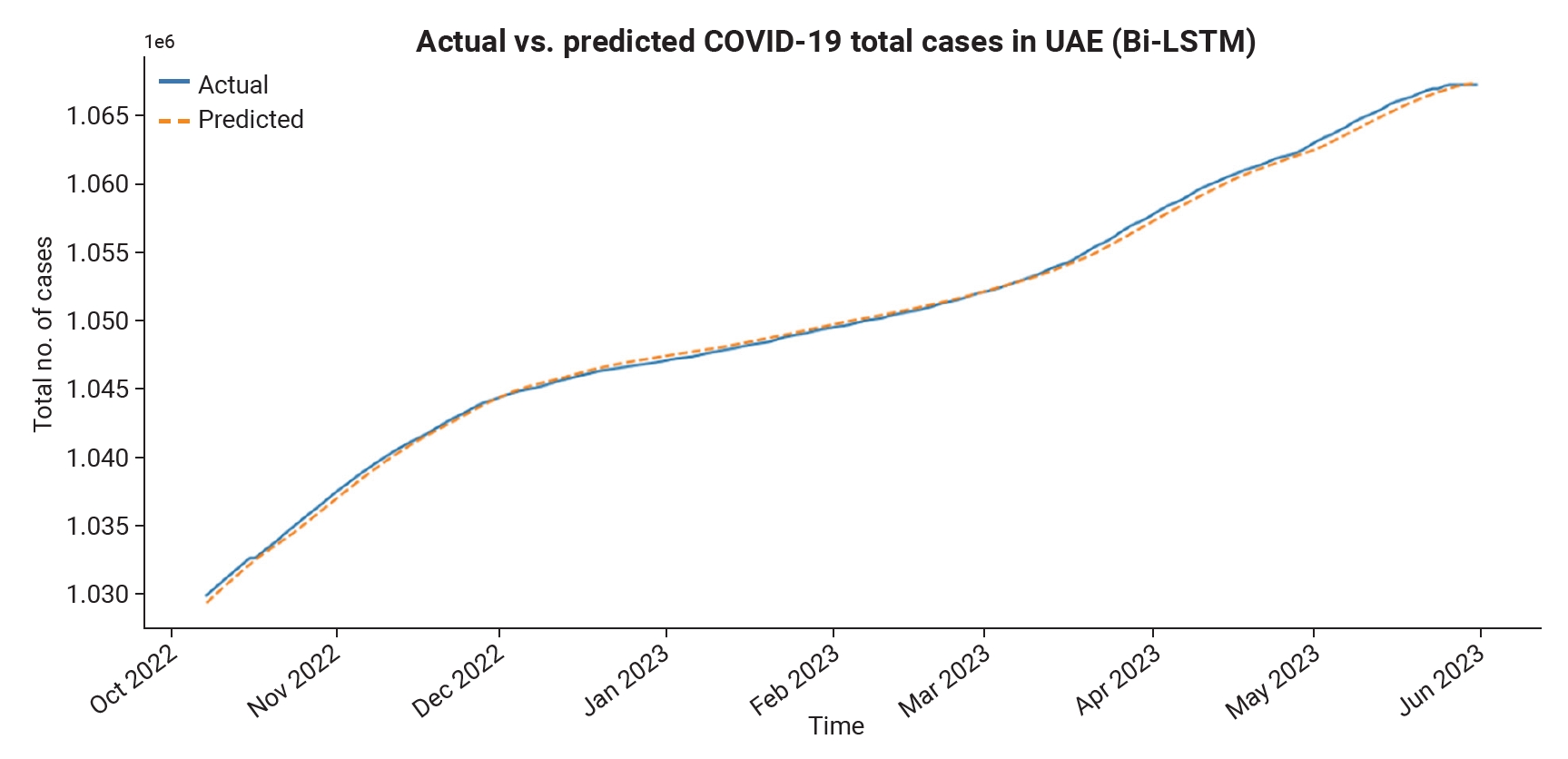
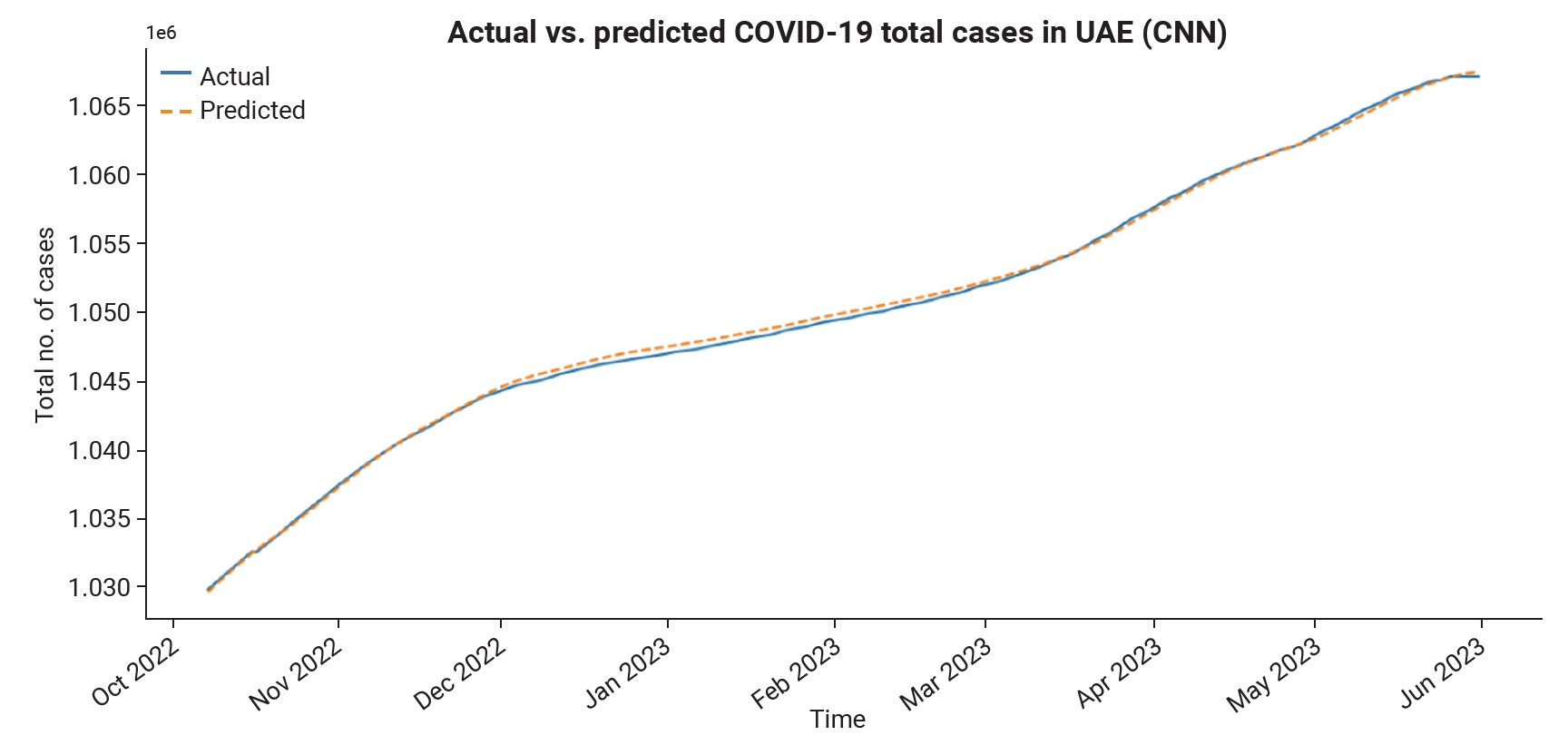
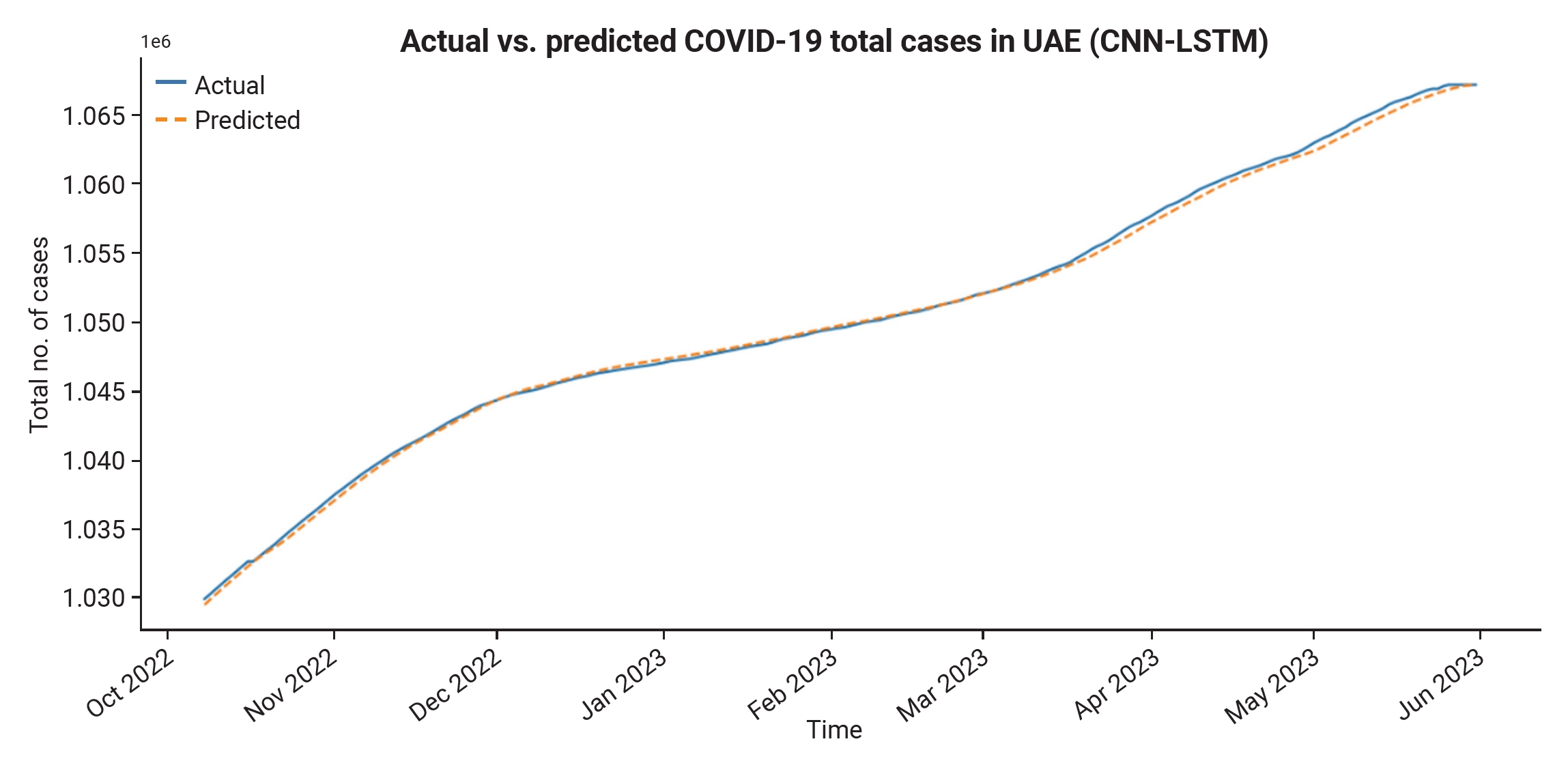
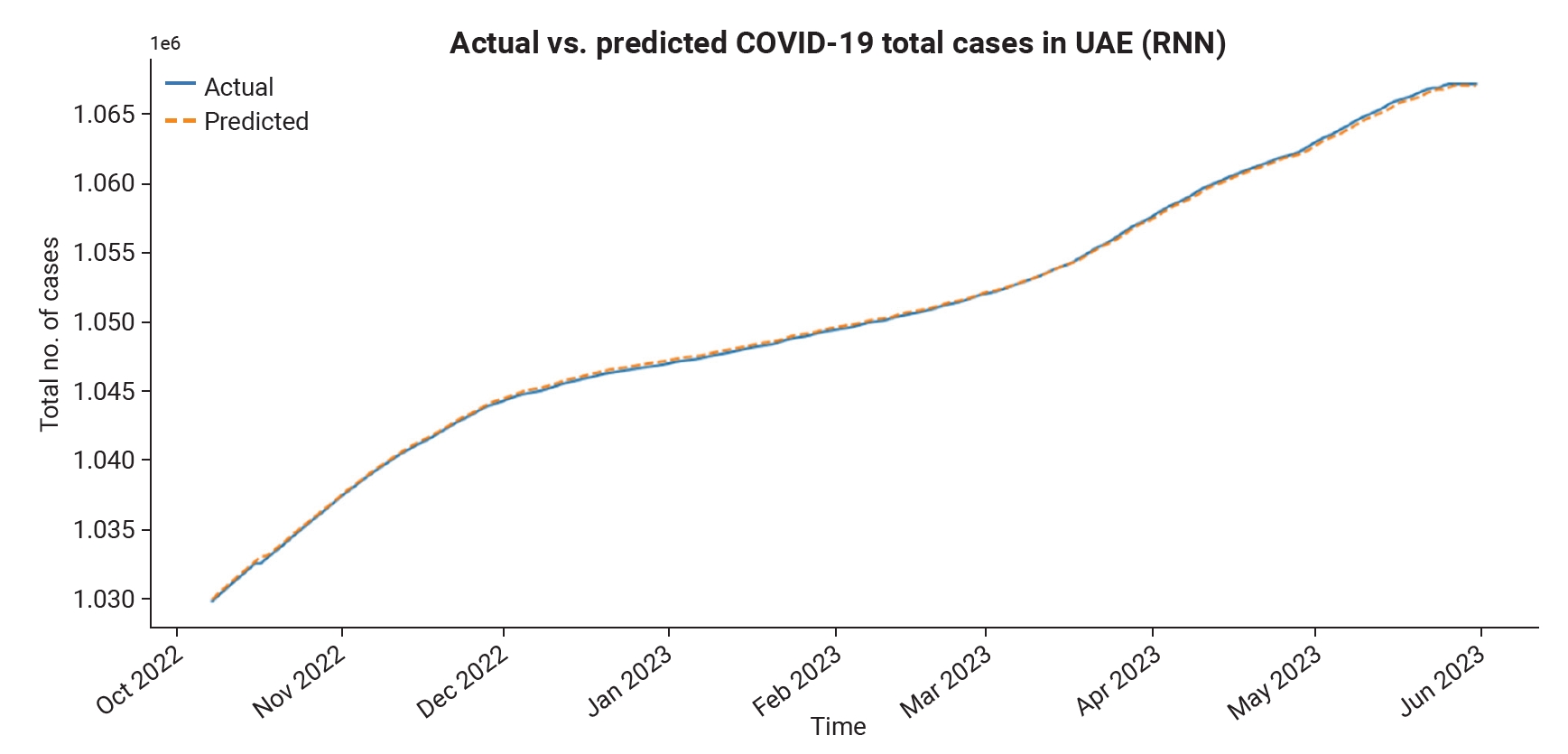
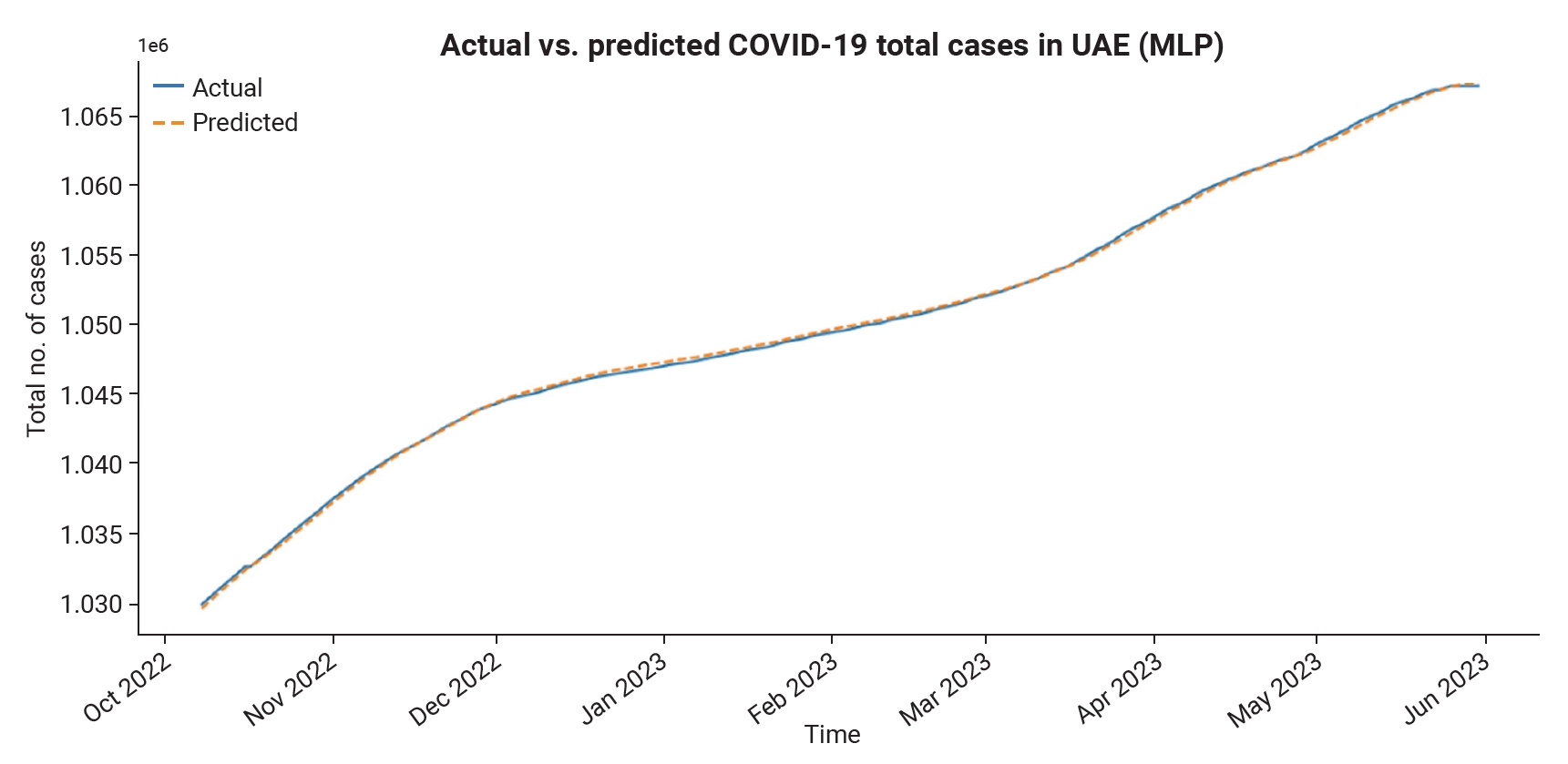
- 1. Abbasimehr H, Paki R. Prediction of COVID-19 confirmed cases combining deep learning methods and Bayesian optimization. Chaos Solitons Fractals 2021;142:110511. ArticlePubMed
- 2. Ali S, Sahoo B, Zelikovsky A, et al. Benchmarking machine learning robustness in COVID-19 genome sequence classification. Sci Rep 2023;13:4154. ArticlePubMedPMCPDF
- 3. Althoey F, Akhter MN, Nagra ZS, et al. Prediction models for Marshall mix parameters using bio-inspired genetic programming and deep machine learning approaches: a comparative study. Case Stud Constr Mater 2023;18:e01774.Article
- 4. Atik I. A new CNN-based method for short-term forecasting of electrical energy consumption in the COVID-19 period: the case of Turkey. IEEE Access 2022;10:22586−98.Article
- 5. Moujahid H, Cherradi B, Al-Sarem M, et al. Combining CNN and Grad-Cam for COVID-19 disease prediction and visual explanation. Intell Autom Soft Comput 2022;32:723−45.Article
- 6. Mohimont L, Chemchem A, Alin F, et al. Convolutional neural networks and temporal CNNs for COVID-19 forecasting in France. Appl Intell (Dordr) 2021;51:8784−809.ArticlePubMedPMCPDF
- 7. ArunKumar KE, Kalaga DV, Kumar CM, et al. Comparative analysis of gated recurrent units (GRU), long short-term memory (LSTM) cells, autoregressive integrated moving average (ARIMA), seasonal autoregressive Integrated moving average (SARIMA) for forecasting COVID-19 trends. Alex Eng J 2022;61:7585−603.Article
- 8. ArunKumar KE, Kalaga DV, Sai Kumar CM, et al. Forecasting the dynamics of cumulative COVID-19 cases (confirmed, recovered and deaths) for top-16 countries using statistical machine learning models: auto-regressive integrated moving average (ARIMA) and seasonal auto-regressive integrated moving average (SARIMA). Appl Soft Comput 2021;103:107161. ArticlePubMedPMC
- 9. Arora P, Kumar H, Panigrahi BK. Prediction and analysis of COVID-19 positive cases using deep learning models: a descriptive case study of India. Chaos Solitons Fractals 2020;139:110017. ArticlePubMedPMC
- 10. Aldhyani TH, Alkahtani H. A bidirectional long short-term memory model algorithm for predicting COVID-19 in gulf countries. Life (Basel) 2021;11:1118. ArticlePubMedPMC
- 11. Bassiouni MM, Chakrabortty RK, Hussain OK, et al. Advanced deep learning approaches to predict supply chain risks under COVID-19 restrictions. Expert Syst Appl 2023;211:118604. ArticlePubMed
- 12. Shakeel SM, Kumar NS, Madalli PP, et al. COVID-19 prediction models: a systematic literature review. Osong Public Health Res Perspect 2021;12:215−29.ArticlePubMedPMCPDF
- 13. Sinha T, Chowdhury T, Shaw RN, et al. Analysis and prediction of COVID-19 confirmed cases using deep learning models: a comparative study. In: Advanced Computing and Intelligent Technologies: Proceedings of the International Conference on Advanced Computing and Intelligent Technologies (ICACIT); 2021 Mar; New Delhi, India. Springer; 2022. p. 207–18.Article
- 14. Sujath R, Chatterjee JM, Hassanien AE. A machine learning forecasting model for COVID-19 pandemic in India. Stoch Environ Res Risk Assess 2020;34:959−72.ArticlePubMedPMCPDF
- 15. Satu MS, Howlader KC, Mahmud M, et al. Short-term prediction of COVID-19 cases using machine learning models. Appl Sci 2021;11:4266. Article
- 16. Istaiteh O, Owais T, Al-Mad N, et al. Machine learning approaches for covid-19 forecasting. In: 2020 International Conference on Intelligent Data Science Technologies and Applications (IDSTA); 2020 Oct 19-22; Valencia, Spain; IEEE; 2020. p. 50−7.Article
- 17. Musulin J, Baressi Segota S, Stifanic D, et al. Application of artificial intelligence-based regression methods in the problem of COVID-19 spread prediction: a systematic review. Int J Environ Res Public Health 2021;18:4287. ArticlePubMedPMC
- 18. Marzouk M, Elshaboury N, Abdel-Latif A, et al. Deep learning model for forecasting COVID-19 outbreak in Egypt. Process Saf Environ Prot 2021;153:363−75.ArticlePubMedPMC
- 19. Pham P, Pedrycz W, Vo B. Dual attention-based sequential auto-encoder for COVID-19 outbreak forecasting: a case study in Vietnam. Expert Syst Appl 2022;203:117514. ArticlePubMedPMC
- 20. Rahimi I, Chen F, Gandomi AH. A review on COVID-19 forecasting models. Neural Comput Appl 2021;1−11.ArticlePDF
- 21. Kassanuk T, Phasinam K. A hybrid binary bird swarm optimization (BSO) and dragonfly algorithm (DA) for VM allocation and load balancing in Cloud. Int J Cloud Appl Comput 2023;13:1−21.Article
- 22. Rauf HT, Lali MI, Khan MA, et al. Time series forecasting of COVID-19 transmission in Asia Pacific countries using deep neural networks. Pers Ubiquitous Comput 2023;27:733−50.ArticlePubMedPDF
- 23. Huang CJ, Shen Y, Kuo PH, et al. Novel spatiotemporal feature extraction parallel deep neural network for forecasting confirmed cases of coronavirus disease 2019. Socioecon Plann Sci 2022;80:100976. ArticlePubMed
- 24. Fu X, Wu M, Tiong RL, et al. Data-driven real-time advanced geological prediction in tunnel construction using a hybrid deep learning approach. Autom Constr 2023;146:104672. Article
- 25. Ghosh I, Alfaro-Cortes E, Gamez M, et al. Role of proliferation COVID-19 media chatter in predicting Indian stock market: integrated framework of nonlinear feature transformation and advanced AI. Expert Syst Appl 2023;219:119695. ArticlePubMedPMC
- 26. Agarwal K, Choudhury S, Tipirneni S, et al. Preparing for the next pandemic via transfer learning from existing diseases with hierarchical multi-modal BERT: a study on COVID-19 outcome prediction. Sci Rep 2022;12:10748. ArticlePubMedPMCPDF
- 27. Haggerty R, Sun J, Yu H, et al. Application of machine learning in groundwater quality modeling: a comprehensive review. Water Res 2023;233:119745. ArticlePubMed
- 28. Mazhar T, Asif RN, Malik MA, et al. Electric vehicle charging system in the smart grid using different machine learning methods. Sustainability 2023;15:2603. Article
- 29. Sahoo SK, Palai G, Altahan BR, et al. An optimized deep learning approach for the prediction of social distance among individuals in public places during pandemic. New Gener Comput 2023;41:135−54.ArticlePubMedPMCPDF
- 30. Fifita F, Smith J, Hanzsek-Brill MB, et al. Machine learning-based identifications of COVID-19 fake news using biomedical information extraction. Big Data Cogn Comput 2023;7:46. Article
- 31. Shareefa P, Maheshwari PU, Donald AD, et al. Forecasting the future: predicting COVID-19 trends with machine learning. Int J Adv Res Sci Commun Technol 2023;3:347−55.
- 32. Ajagbe SA, Adigun MO. Deep learning techniques for detection and prediction of pandemic diseases: a systematic literature review. Multimed Tools Appl 2024;83:5893−927.ArticlePDF
- 33. Li Y, Liang M, Li H, et al. Deep learning-powered vessel traffic flow prediction with spatial-temporal attributes and similarity grouping. Eng Appl Artif Intell 2023;126(Part B). 107012. Article
- 34. Chimmula VK, Zhang L. Time series forecasting of COVID-19 transmission in Canada using LSTM networks. Chaos Solitons Fractals 2020;135:109864. ArticlePubMedPMC
- 35. Devaraj J, Madurai Elavarasan R, Pugazhendhi R, et al. Forecasting of COVID-19 cases using deep learning models: is it reliable and practically significant? Results Phys 2021;21:103817. ArticlePubMedPMC
- 36. Lasker A, Ghosh M, Obaidullah SM, et al. LWSNet: a novel deep-learning architecture to segregate COVID-19 and pneumonia from X-ray imagery. Multimed Tools Appl 2023;82:21801−23.ArticlePubMedPDF
- 37. Adamidi ES, Mitsis K, Nikita KS. Artificial intelligence in clinical care amidst COVID-19 pandemic: a systematic review. Comput Struct Biotechnol J 2021;19:2833−50.ArticlePubMedPMC
- 38. Ma QL, Huang FM, Guo W, et al. Machine learning classification of time since BNT162b2 COVID-19 vaccination based on array-measured antibody activity. Life (Basel) 2023;13:1304. ArticlePubMedPMC
- 39. Santangelo OE, Gentile V, Pizzo S, et al. Machine learning and prediction of infectious diseases: a systematic review. Mach Learn Knowl Extr 2023;5:175−98.Article
- 40. Alyasseri ZA, Al-Betar MA, Doush IA, et al. Review on COVID-19 diagnosis models based on machine learning and deep learning approaches. Expert Syst 2022;39:e12759.PubMed
- 41. Tsai PH, Lai WY, Lin YY, et al. Clinical manifestation and disease progression in COVID-19 infection. J Chin Med Assoc 2021;84:3−8.ArticlePubMed
- 42. Islam R, Abdel-Raheem E, Tarique M. Early detection of COVID-19 patients using chromagram features of cough sound recordings with machine learning algorithms. In: 2021 International Conference on Microelectronics; 2021 Dec 19-22; New Cairo City, Egypt. IEEE; 2021. p. 82–5.Article
- 43. Sadefo Kamdem J, Bandolo Essomba R, Njong Berinyuy J. Deep learning models for forecasting and analyzing the implications of COVID-19 spread on some commodities markets volatilities. Chaos Solitons Fractals 2020;140:110215. ArticlePubMedPMC
- 44. Jing N, Shi Z, Hu Y, et al. Cross-sectional analysis and data-driven forecasting of confirmed COVID-19 cases. Appl Intell (Dordr) 2022;52:3303−18.ArticlePubMedPDF
- 45. Ahamed KU, Islam M, Uddin A, et al. A deep learning approach using effective preprocessing techniques to detect COVID-19 from chest CT-scan and X-ray images. Comput Biol Med 2021;139:105014. ArticlePubMedPMC
- 46. Guo W, Li M, Dong Y, et al. Diabetes is a risk factor for the progression and prognosis of COVID-19. Diabetes Metab Res Rev 2020;36:e3319.PubMedPMC
- 47. Kerr CC, Stuart RM, Mistry D, et al. Covasim: an agent-based model of COVID-19 dynamics and interventions. PLoS Comput Biol 2021;17:e1009149.ArticlePubMedPMC
- 48. Lv H, Shi L, Berkenpas JW, et al. Application of artificial intelligence and machine learning for COVID-19 drug discovery and vaccine design. Brief Bioinform 2021;22:bbab320. ArticlePubMedPDF
- 49. Rendeiro AF, Ravichandran H, Bram Y, et al. The spatial landscape of lung pathology during COVID-19 progression. Nature 2021;593:564−9.ArticlePubMedPMCPDF
- 50. Faruqui N, Yousuf MA, Whaiduzzaman M, et al. LungNet: a hybrid deep-CNN model for lung cancer diagnosis using CT and wearable sensor-based medical IoT data. Comput Biol Med 2021;139:104961. ArticlePubMed
- 51. Sarker S, Jamal L, Ahmed SF, et al. Robotics and artificial intelligence in healthcare during COVID-19 pandemic: a systematic review. Rob Auton Syst 2021;146:103902. ArticlePubMedPMC
- 52. Shastri S, Singh K, Kumar S, et al. Time series forecasting of COVID-19 using deep learning models: India-USA comparative case study. Chaos Solitons Fractals 2020;140:110227. ArticlePubMedPMC
- 53. Xie J, Wang M, Liu R. Deep learning-based COVID-19 diagnosis and trend predictions. Edited by Joshi A, Dey N, Santosh K: Intelligent systems and methods to combat COVID-19. Singapore: Springer; 2020. pp 57−64.
- 54. Syeda HB, Syed M, Sexton KW, et al. Role of machine learning techniques to tackle the COVID-19 crisis: systematic review. JMIR Med Inform 2021;9:e23811.ArticlePubMedPMC
- 55. Tomar A, Gupta N. Prediction for the spread of COVID-19 in India and effectiveness of preventive measures. Sci Total Environ 2020;728:138762. ArticlePubMedPMC
- 56. Tuli S, Tuli S, Tuli R, et al. Predicting the growth and trend of COVID-19 pandemic using machine learning and cloud computing. Internet Things 2020;11:100222. Article
- 57. Tudose AM, Picioroaga II, Sidea DO, et al. Short-term load forecasting using convolutional neural networks in COVID-19 context: the Romanian case study. Energies 2021;14:4046. Article
- 58. Kaleem S, Sohail A, Tariq MU, et al. Ensemble learning for multi-class COVID-19 detection from big data. PLoS One 2023;18:e0292587.ArticlePubMedPMC
- 59. Vaishya R, Javaid M, Khan IH, et al. Artificial Intelligence (AI) applications for COVID-19 pandemic. Diabetes Metab Syndr 2020;14:337−9.ArticlePubMedPMC
- 60. Dairi A, Harrou F, Zeroual A, et al. Comparative study of machine learning methods for COVID-19 transmission forecasting. J Biomed Inform 2021;118:103791. ArticlePubMedPMC
- 61. Wang P, Zheng X, Ai G, et al. Time series prediction for the epidemic trends of COVID-19 using the improved LSTM deep learning method: case studies in Russia, Peru and Iran. Chaos Solitons Fractals 2020;140:110214. ArticlePubMedPMC
- 62. Zhan C, Zheng Y, Zhang H, et al. Random-forest-bagging broad learning system with applications for COVID-19 pandemic. IEEE Internet Things J 2021;8:15906−18.ArticlePubMedPMC
- 63. Zoabi Y, Deri-Rozov S, Shomron N. Machine learning-based prediction of COVID-19 diagnosis based on symptoms. NPJ Digit Med 2021;4:3. ArticlePubMedPMCPDF
- 64. Abdul Salam M, Taha S, Ramadan M. COVID-19 detection using federated machine learning. PLoS One 2021;16:e0252573.ArticlePubMedPMC
- 65. Bi L, Fili M, Hu G. COVID-19 forecasting and intervention planning using gated recurrent unit and evolutionary algorithm. Neural Comput Appl 2022;34:17561−79.ArticlePubMedPMCPDF
- 66. Dogan O, Tiwari S, Jabbar MA, et al. A systematic review on AI/ML approaches against COVID-19 outbreak. Complex Intell Systems 2021;7:2655−78.ArticlePubMedPMCPDF
- 67. Dutta S, Bandyopadhyay SK. Machine learning approach for confirmation of COVID-19 cases: positive, negative, death and release. [Preprint] Posted 2020 Mar 30. MedRxiv. https://doi.org/10.1101/2020.03.25.20043505.Article
- 68. Elsheikh AH, Saba AI, Elaziz MA, et al. Deep learning-based forecasting model for COVID-19 outbreak in Saudi Arabia. Process Saf Environ Prot 2021;149:223−33.ArticlePubMed
- 69. Ezugwu AE, Hashem IA, Oyelade ON, et al. A novel smart city-based framework on perspectives for application of machine learning in combating COVID-19. Biomed Res Int 2021;2021:5546790. ArticlePubMedPMCPDF
- 70. Aloufi F, Ibrahim AL, Elsayed AM, et al. Virtual mathematics education during COVID-19: an exploratory study of teaching practices for teachers in simultaneous virtual classes. Int J Learn Teach Educ Res 2021;20:85−113.Article
- 71. Tashtoush MA, Wardat Y, Elsayed AM. Mathematics distance learning and learning loss during COVID-19 pandemic: teachers’ perspectives. J High Educ Theory Pract 2023;23:162−74.
- 72. Zhang J, Litvinova M, Liang Y, et al. Changes in contact patterns shape the dynamics of the COVID-19 outbreak in China. Science 2020;368:1481−6.ArticlePubMedPMC
- 73. Firouzbakht M, Omidvar S, Firouzbakht S, et al. COVID-19 preventive behaviors and influencing factors in the Iranian population; a web-based survey. BMC Public Health 2021;21:143. ArticlePubMedPMCPDF
- 74. Tashtoush MA, Wardat Y, Aloufi F, et al. The effectiveness of teaching method based on the components of concept-rich instruction approach in students achievement on linear algebra course and their attitudes towards mathematics. J High Educ Theory Pract 2022;22:41−57.
- 75. Huang CJ, Chen YH, Ma Y, et al. Multiple-input deep convolutional neural network model for COVID-19 forecasting in China [Preprint]. Posted 2020 Mar 27. MedRxiv 2020.03.23.20041608. https://doi.org/10.1101/2020.03.23.20041608.Article
- 76. Khan SD, Alarabi L, Basalamah S. Toward smart lockdown: a novel approach for COVID-19 hotspots prediction using a deep hybrid neural network. Computers 2020;9:99. Article
References
Figure & Data
References
Citations



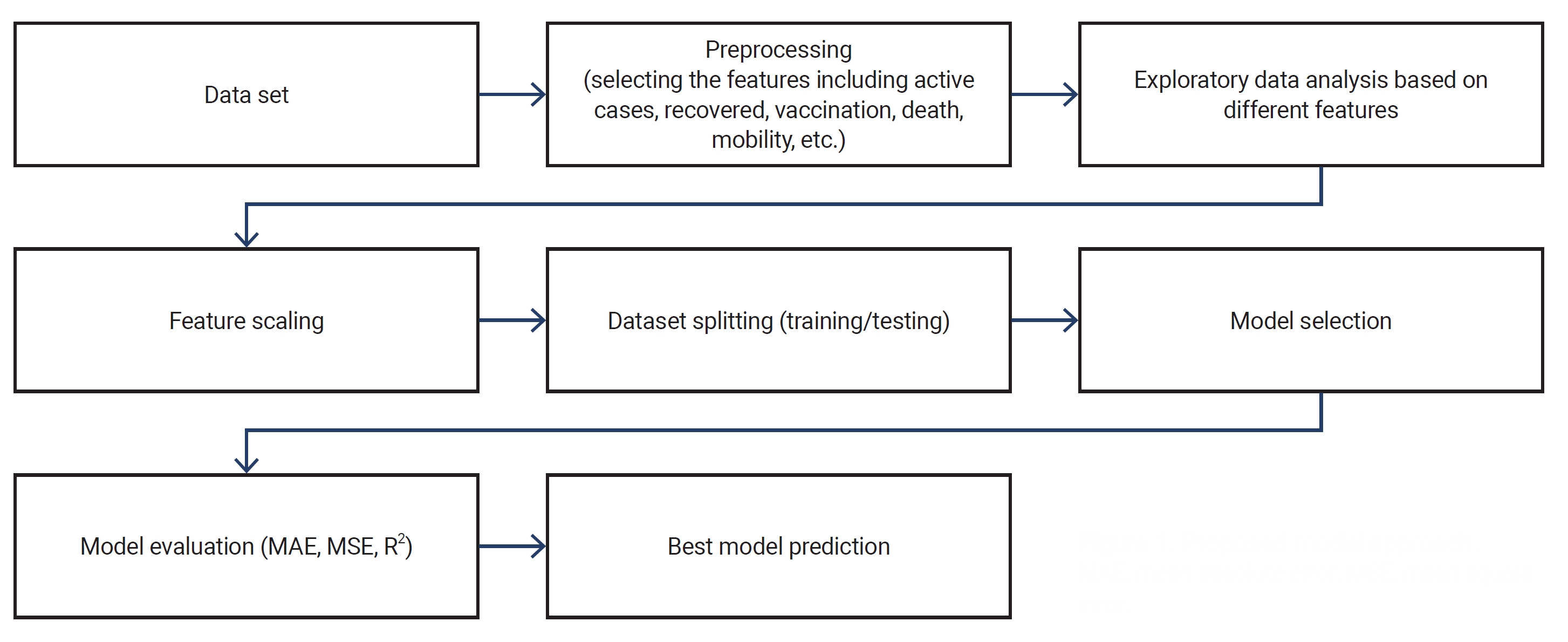
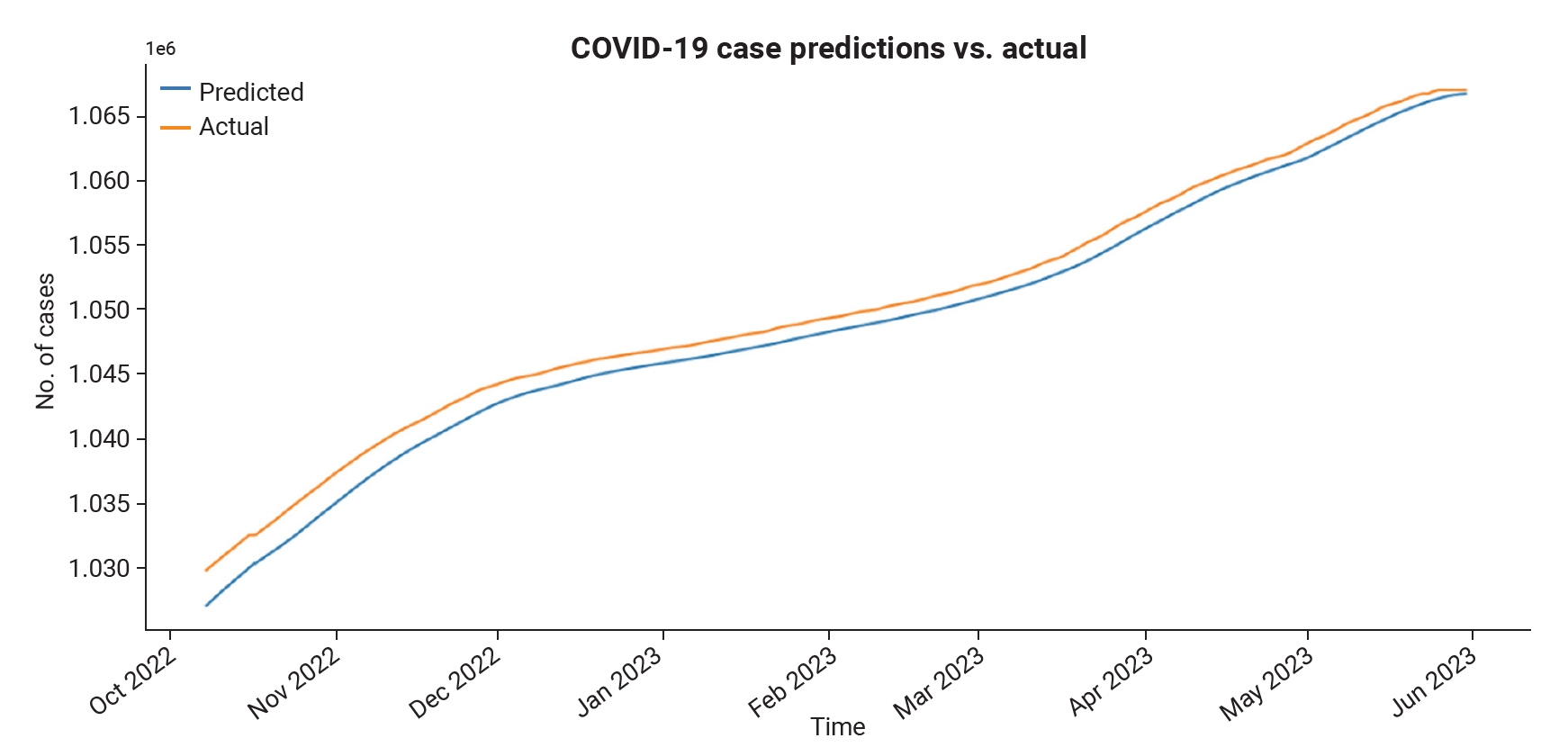
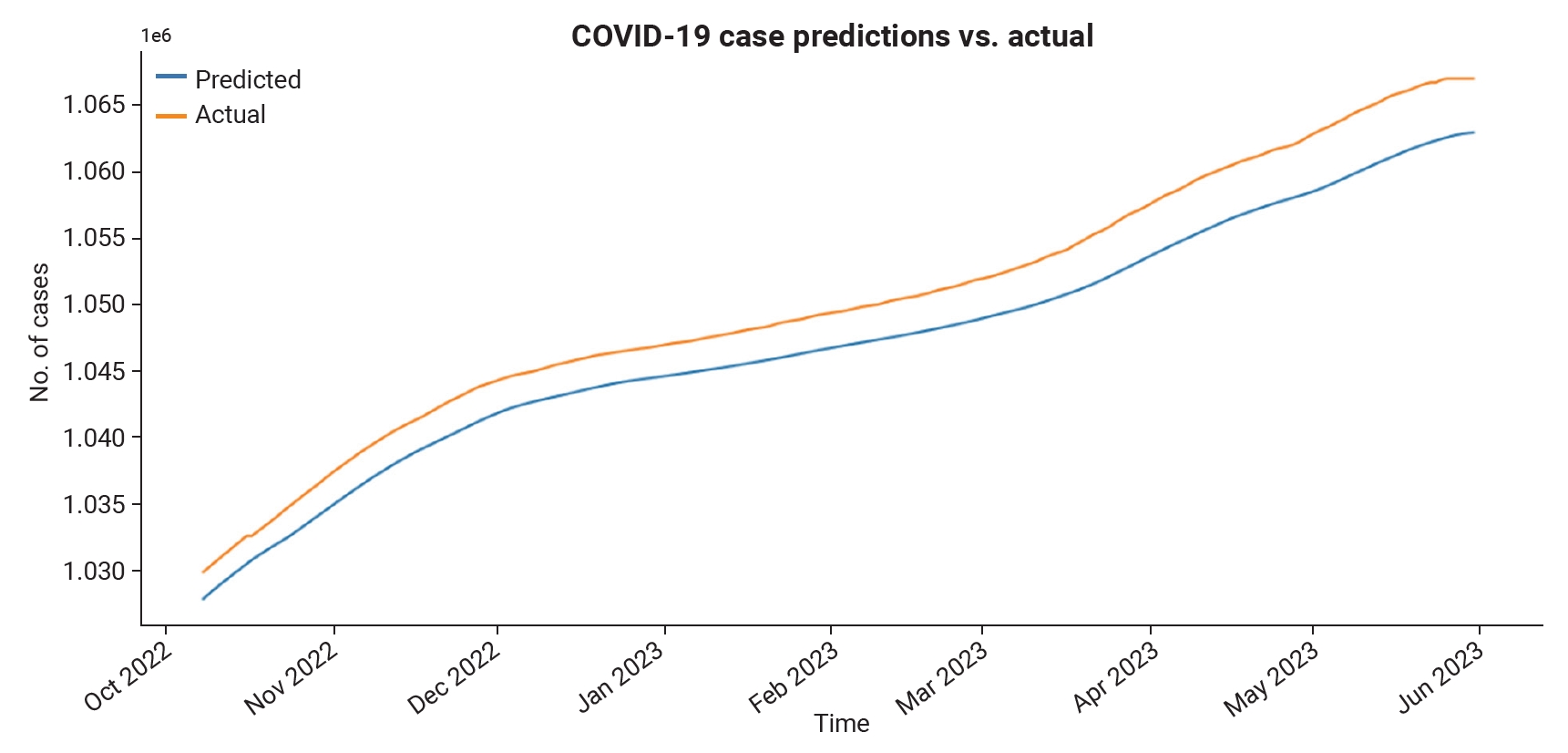
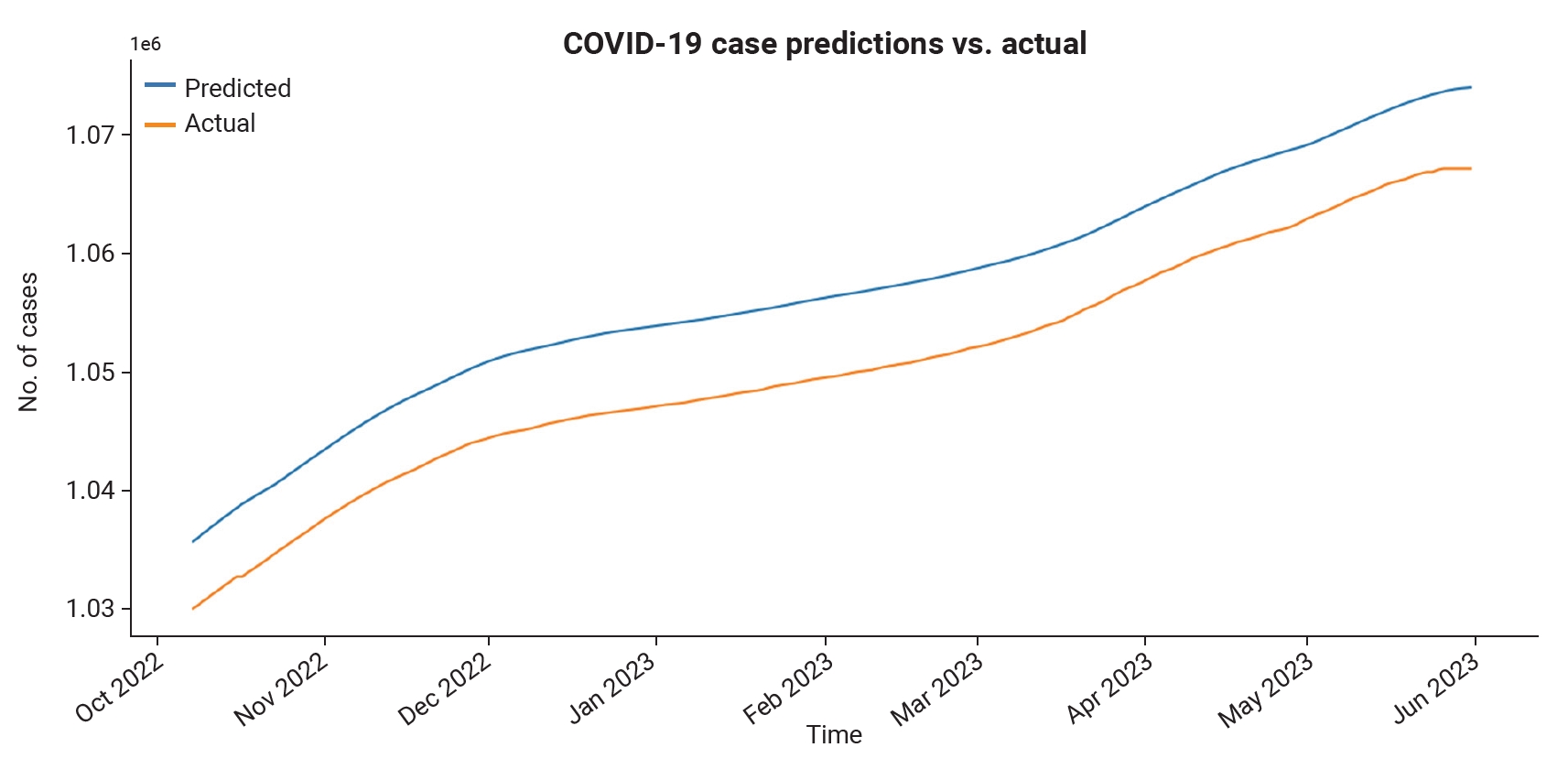
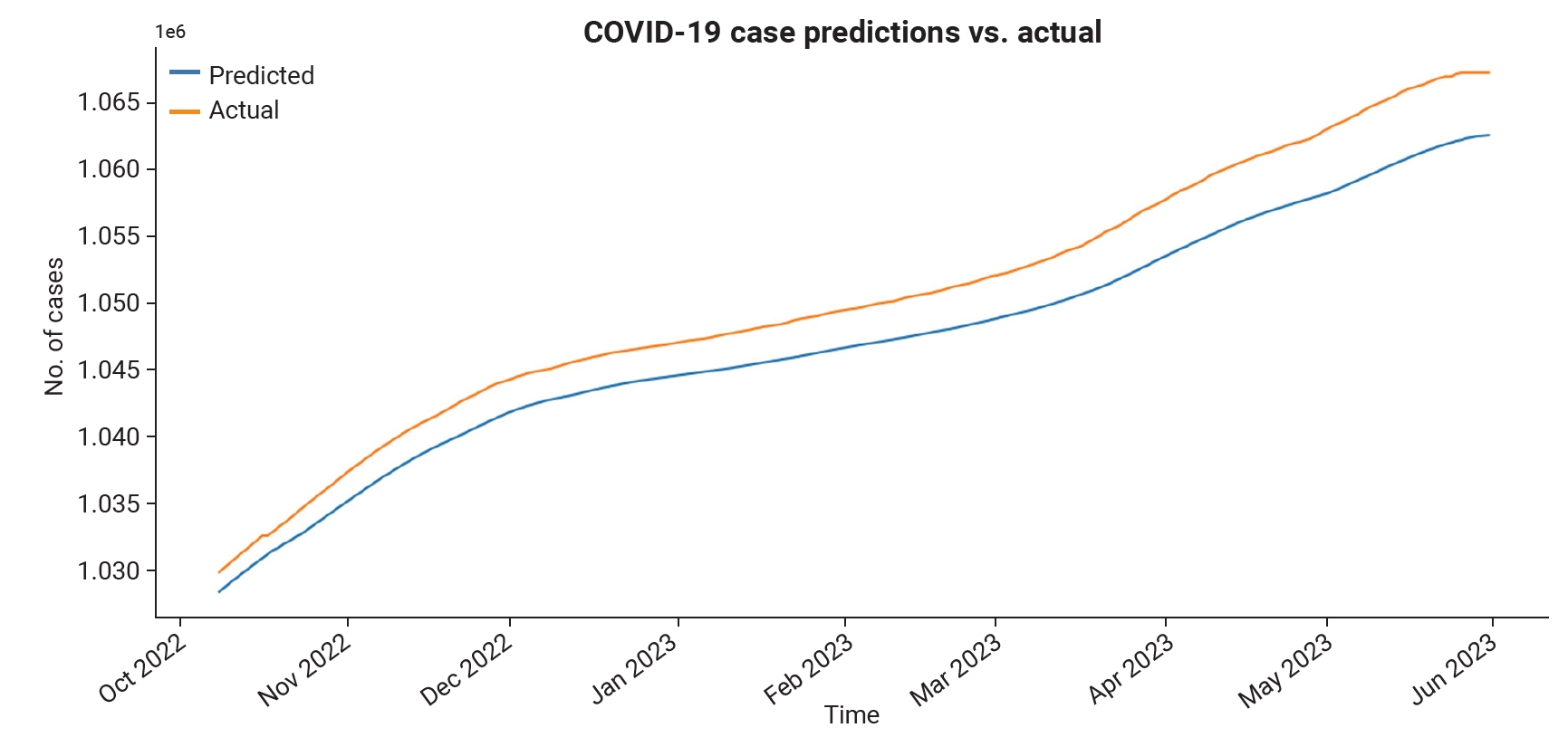
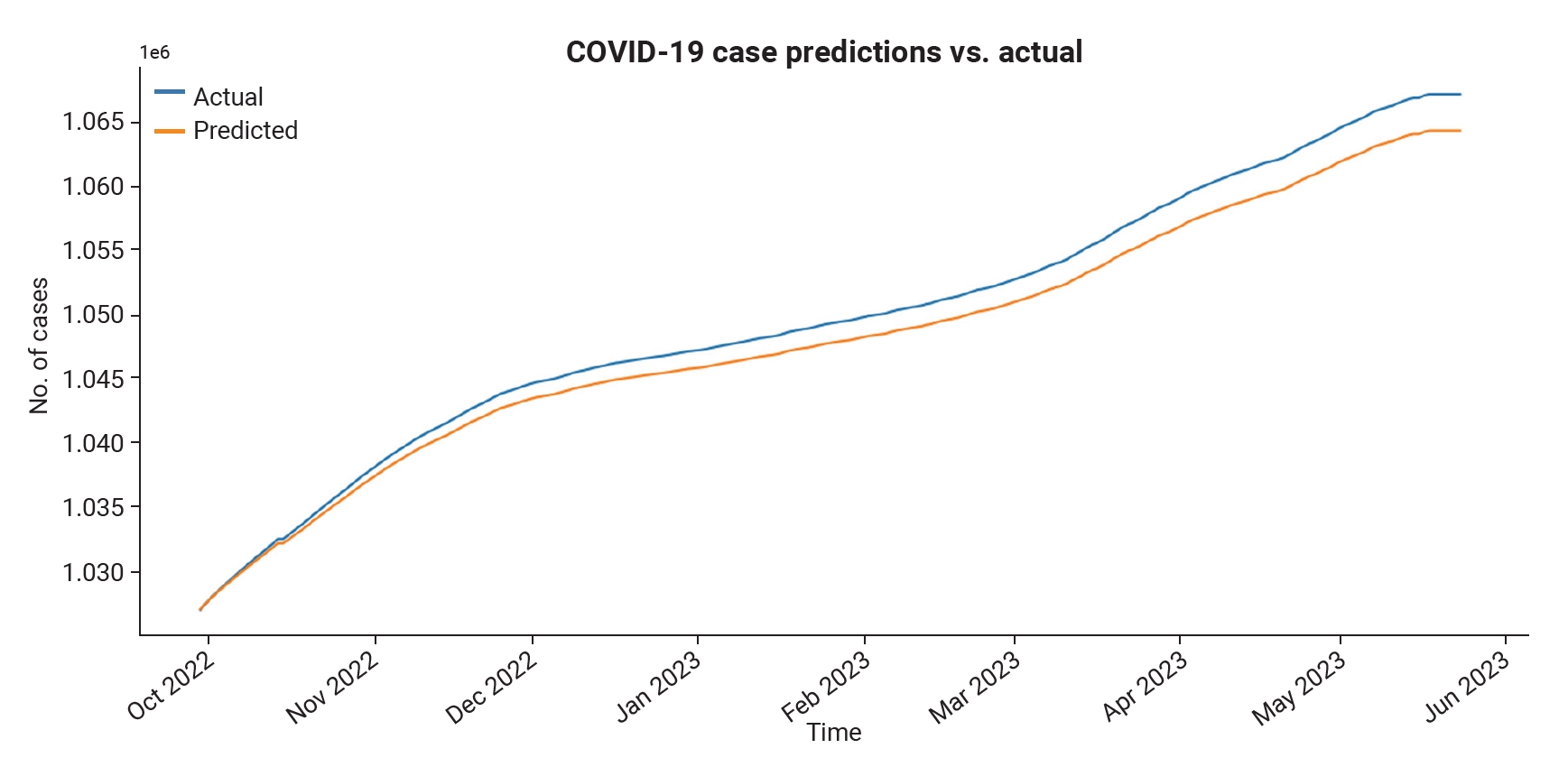
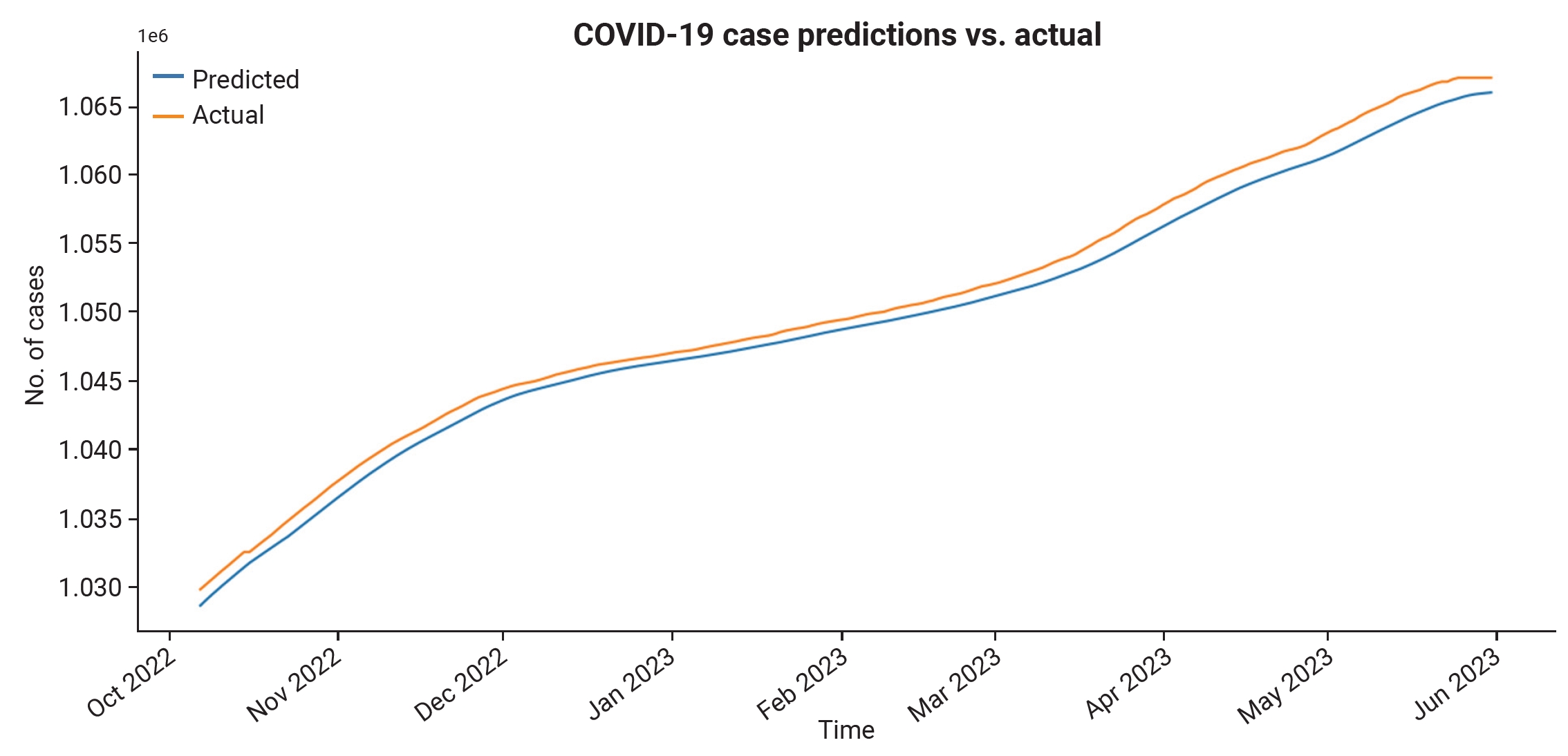

 Cite
Cite













